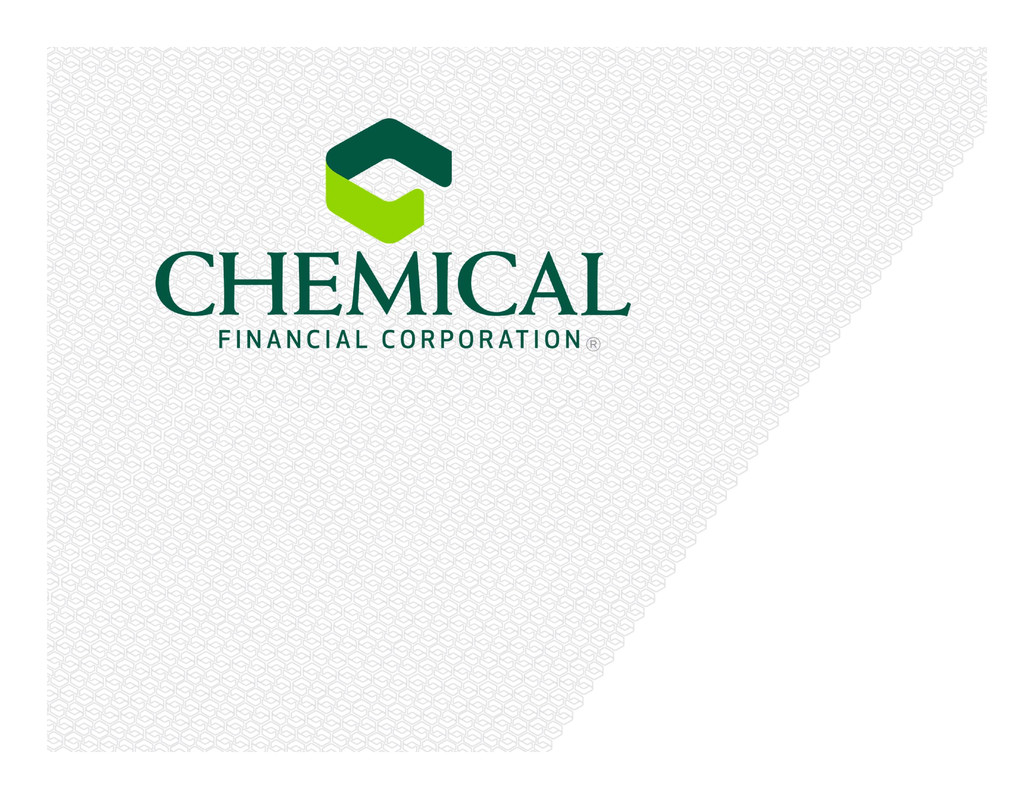Attached files
| file | filename |
|---|---|
| 8-K - 8-K - TCF FINANCIAL CORP | chfc8-kfebruary2018confere.htm |
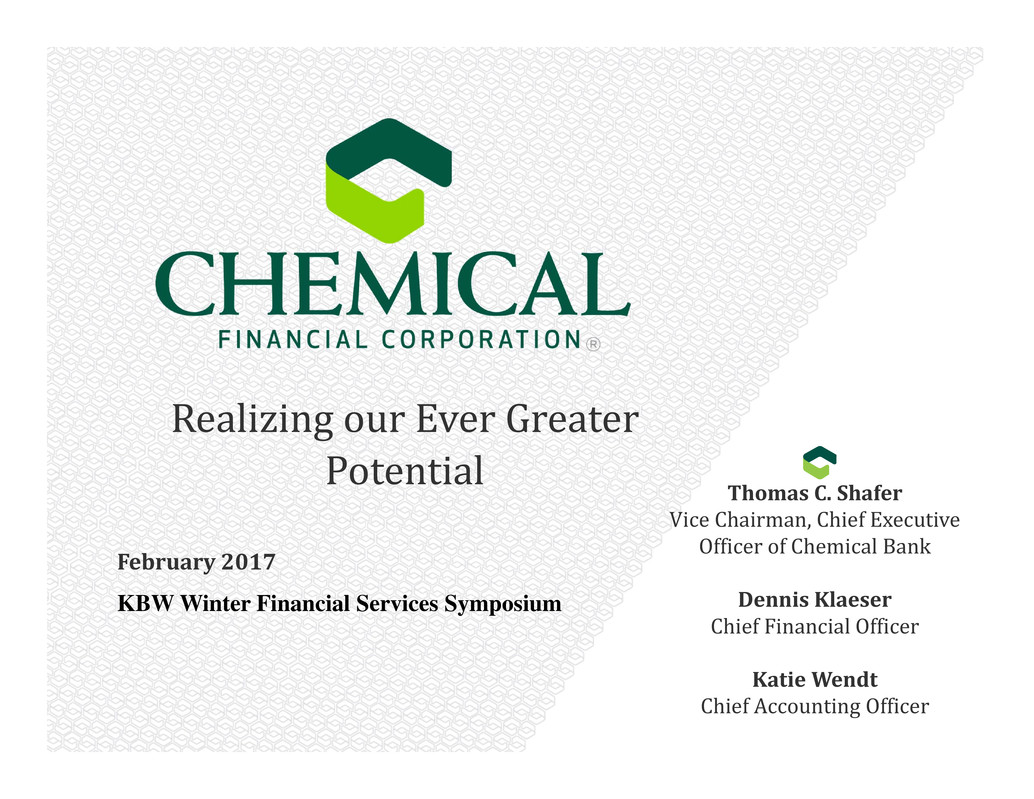
Realizing our Ever Greater
Potential
Thomas C. Shafer
Vice Chairman, Chief Executive
Officer of Chemical Bank
Dennis Klaeser
Chief Financial Officer
Katie Wendt
Chief Accounting Officer
February 2017
KBW Winter Financial Services Symposium
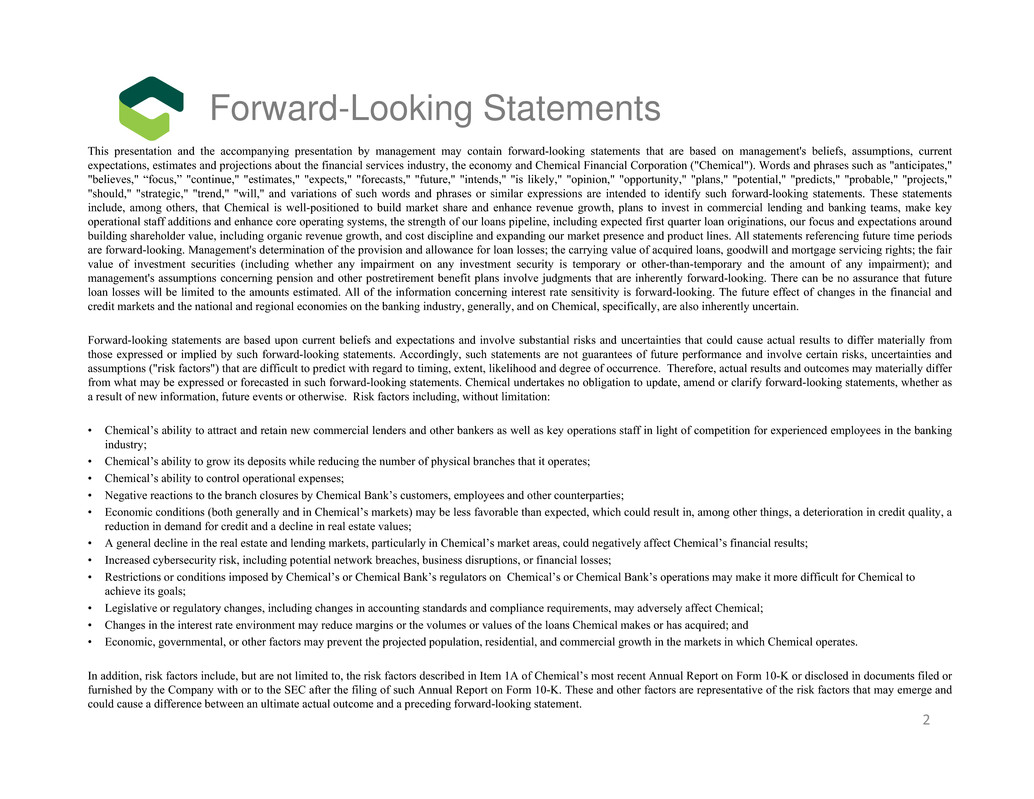
This presentation and the accompanying presentation by management may contain forward-looking statements that are based on management's beliefs, assumptions, current
expectations, estimates and projections about the financial services industry, the economy and Chemical Financial Corporation ("Chemical"). Words and phrases such as "anticipates,"
"believes," “focus,” "continue," "estimates," "expects," "forecasts," "future," "intends," "is likely," "opinion," "opportunity," "plans," "potential," "predicts," "probable," "projects,"
"should," "strategic," "trend," "will," and variations of such words and phrases or similar expressions are intended to identify such forward-looking statements. These statements
include, among others, that Chemical is well-positioned to build market share and enhance revenue growth, plans to invest in commercial lending and banking teams, make key
operational staff additions and enhance core operating systems, the strength of our loans pipeline, including expected first quarter loan originations, our focus and expectations around
building shareholder value, including organic revenue growth, and cost discipline and expanding our market presence and product lines. All statements referencing future time periods
are forward-looking. Management's determination of the provision and allowance for loan losses; the carrying value of acquired loans, goodwill and mortgage servicing rights; the fair
value of investment securities (including whether any impairment on any investment security is temporary or other-than-temporary and the amount of any impairment); and
management's assumptions concerning pension and other postretirement benefit plans involve judgments that are inherently forward-looking. There can be no assurance that future
loan losses will be limited to the amounts estimated. All of the information concerning interest rate sensitivity is forward-looking. The future effect of changes in the financial and
credit markets and the national and regional economies on the banking industry, generally, and on Chemical, specifically, are also inherently uncertain.
Forward-looking statements are based upon current beliefs and expectations and involve substantial risks and uncertainties that could cause actual results to differ materially from
those expressed or implied by such forward-looking statements. Accordingly, such statements are not guarantees of future performance and involve certain risks, uncertainties and
assumptions ("risk factors") that are difficult to predict with regard to timing, extent, likelihood and degree of occurrence. Therefore, actual results and outcomes may materially differ
from what may be expressed or forecasted in such forward-looking statements. Chemical undertakes no obligation to update, amend or clarify forward-looking statements, whether as
a result of new information, future events or otherwise. Risk factors including, without limitation:
• Chemical’s ability to attract and retain new commercial lenders and other bankers as well as key operations staff in light of competition for experienced employees in the banking
industry;
• Chemical’s ability to grow its deposits while reducing the number of physical branches that it operates;
• Chemical’s ability to control operational expenses;
• Negative reactions to the branch closures by Chemical Bank’s customers, employees and other counterparties;
• Economic conditions (both generally and in Chemical’s markets) may be less favorable than expected, which could result in, among other things, a deterioration in credit quality, a
reduction in demand for credit and a decline in real estate values;
• A general decline in the real estate and lending markets, particularly in Chemical’s market areas, could negatively affect Chemical’s financial results;
• Increased cybersecurity risk, including potential network breaches, business disruptions, or financial losses;
• Restrictions or conditions imposed by Chemical’s or Chemical Bank’s regulators on Chemical’s or Chemical Bank’s operations may make it more difficult for Chemical to
achieve its goals;
• Legislative or regulatory changes, including changes in accounting standards and compliance requirements, may adversely affect Chemical;
• Changes in the interest rate environment may reduce margins or the volumes or values of the loans Chemical makes or has acquired; and
• Economic, governmental, or other factors may prevent the projected population, residential, and commercial growth in the markets in which Chemical operates.
In addition, risk factors include, but are not limited to, the risk factors described in Item 1A of Chemical’s most recent Annual Report on Form 10-K or disclosed in documents filed or
furnished by the Company with or to the SEC after the filing of such Annual Report on Form 10-K. These and other factors are representative of the risk factors that may emerge and
could cause a difference between an ultimate actual outcome and a preceding forward-looking statement.
Forward-Looking Statements
2
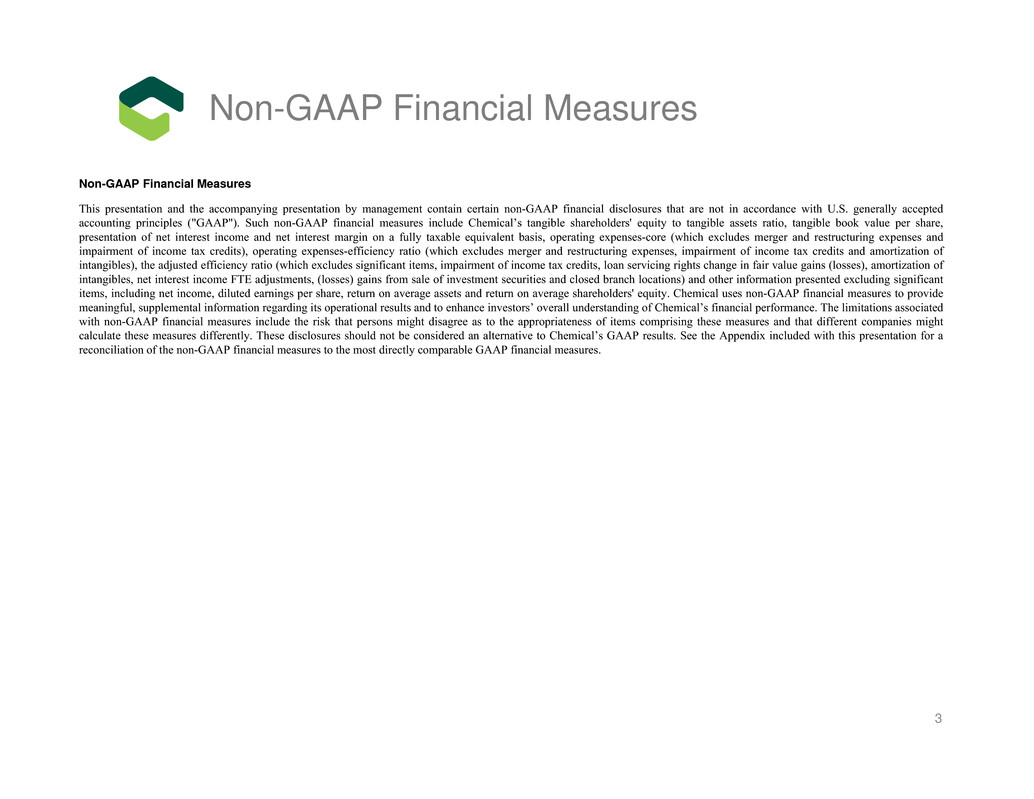
Non-GAAP Financial Measures
This presentation and the accompanying presentation by management contain certain non-GAAP financial disclosures that are not in accordance with U.S. generally accepted
accounting principles ("GAAP"). Such non-GAAP financial measures include Chemical’s tangible shareholders' equity to tangible assets ratio, tangible book value per share,
presentation of net interest income and net interest margin on a fully taxable equivalent basis, operating expenses-core (which excludes merger and restructuring expenses and
impairment of income tax credits), operating expenses-efficiency ratio (which excludes merger and restructuring expenses, impairment of income tax credits and amortization of
intangibles), the adjusted efficiency ratio (which excludes significant items, impairment of income tax credits, loan servicing rights change in fair value gains (losses), amortization of
intangibles, net interest income FTE adjustments, (losses) gains from sale of investment securities and closed branch locations) and other information presented excluding significant
items, including net income, diluted earnings per share, return on average assets and return on average shareholders' equity. Chemical uses non-GAAP financial measures to provide
meaningful, supplemental information regarding its operational results and to enhance investors’ overall understanding of Chemical’s financial performance. The limitations associated
with non-GAAP financial measures include the risk that persons might disagree as to the appropriateness of items comprising these measures and that different companies might
calculate these measures differently. These disclosures should not be considered an alternative to Chemical’s GAAP results. See the Appendix included with this presentation for a
reconciliation of the non-GAAP financial measures to the most directly comparable GAAP financial measures.
Non-GAAP Financial Measures
3

Emphasize our strategy of
being the Premier Midwest
Community Bank
4
1
Demonstrated track record of
organic growth2
Strong performance metrics and
profitability should drive upside3
Realizing our ever greater potential
The largest banking company headquartered in Michigan
Scalable core strategies and disciplines
Proven organic growth initiatives
Leadership in EPS growth among peers (1)
Total Return out-performans (peers and indices) (1)
ROAA(2) 1.3%, ROAE(2) 9.4%, ROATCE(2) 16.5%, low efficiency ratio
Delivering on projected merger benefits
Consistent EPS growth performance
Market share growth
Revenue enhancements
Concentrate on achieving cost savings and exploiting business synergy opportunities
Continue to build out and enhance risk management practices
(1) Source: S&P Global Market Intelligence
(2) ROAA, ROAE and ROATCE, excluding significant items, are non-GAAP financial measure. “Significant items” are defined as merger expenses, restructuring expenses
and the fourth quarter of 2017 losses on sales of investment securities as part of the Corporation’s treasury and tax management objectives. Refer to the Appendix for a
reconciliation of non-GAAP financial measures.
Overview
4
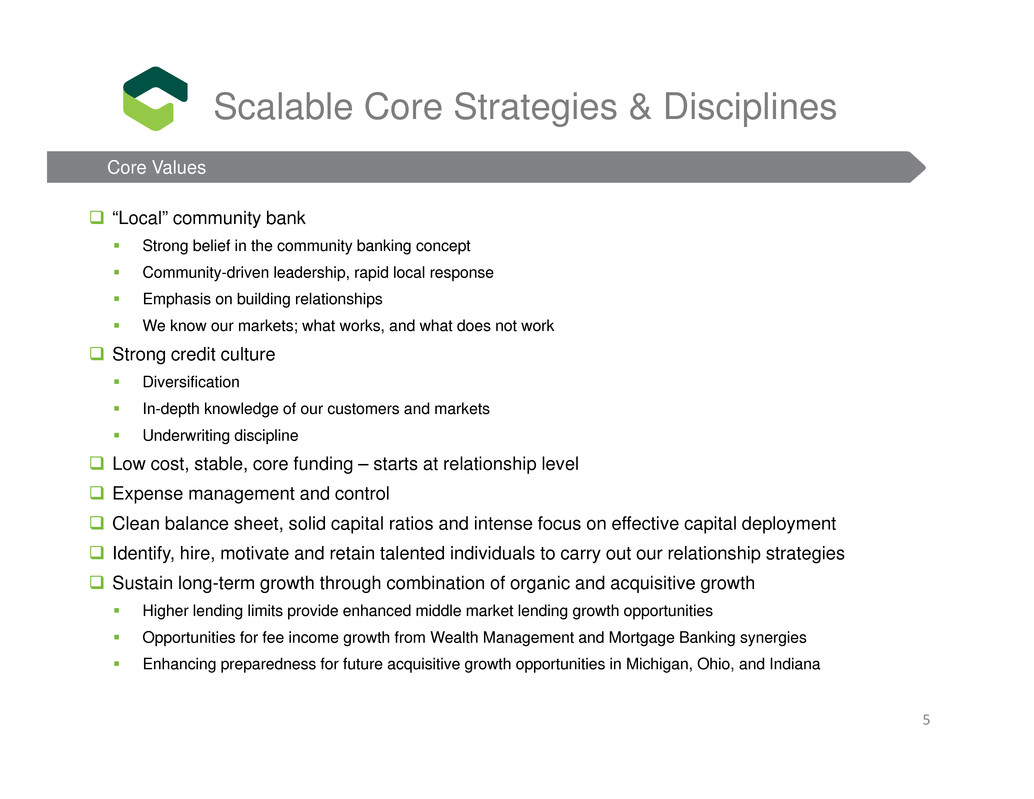
“Local” community bank
Strong belief in the community banking concept
Community-driven leadership, rapid local response
Emphasis on building relationships
We know our markets; what works, and what does not work
Strong credit culture
Diversification
In-depth knowledge of our customers and markets
Underwriting discipline
Low cost, stable, core funding – starts at relationship level
Expense management and control
Clean balance sheet, solid capital ratios and intense focus on effective capital deployment
Identify, hire, motivate and retain talented individuals to carry out our relationship strategies
Sustain long-term growth through combination of organic and acquisitive growth
Higher lending limits provide enhanced middle market lending growth opportunities
Opportunities for fee income growth from Wealth Management and Mortgage Banking synergies
Enhancing preparedness for future acquisitive growth opportunities in Michigan, Ohio, and Indiana
Scalable Core Strategies & Disciplines
Core Values
5
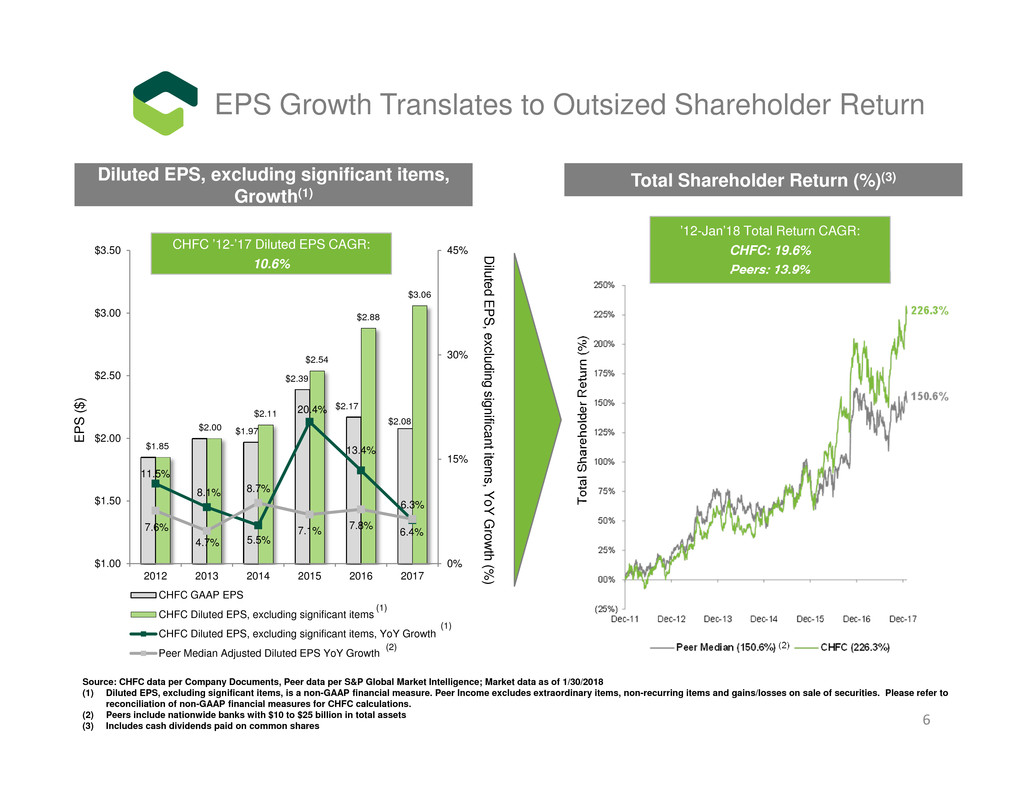
6
EPS Growth Translates to Outsized Shareholder Return
Source: CHFC data per Company Documents, Peer data per S&P Global Market Intelligence; Market data as of 1/30/2018
(1) Diluted EPS, excluding significant items, is a non-GAAP financial measure. Peer Income excludes extraordinary items, non-recurring items and gains/losses on sale of securities. Please refer to
reconciliation of non-GAAP financial measures for CHFC calculations.
(2) Peers include nationwide banks with $10 to $25 billion in total assets
(3) Includes cash dividends paid on common shares
Diluted EPS, excluding significant items,
Growth(1)
Total Shareholder Return (%)(3)
(2)
E
P
S
(
$
)
D
iluted E
P
S
, excluding significant item
s, Y
oY
G
row
th (%
)
T
o
t
a
l
S
h
a
r
e
h
o
l
d
e
r
R
e
t
u
r
n
(
%
)
(2)
CHFC ’12-’17 Diluted EPS CAGR:
10.6%
(1)
(1)
’12-Jan’18 Total Return CAGR:
CHFC: 19.6%
Peers: 13.9%
$1.97
$2.39
$2.17
$2.08
$1.85
$2.00
$2.11
$2.54
$2.88
$3.06
11.5%
8.1%
5.5%
20.4%
13.4%
6.3%
7.6%
4.7%
8.7%
7.1% 7.8% 6.4%
0%
15%
30%
45%
$1.00
$1.50
$2.00
$2.50
$3.00
$3.50
2012 2013 2014 2015 2016 2017
CHFC GAAP EPS
CHFC Diluted EPS, excluding significant items
CHFC Diluted EPS, excluding significant items, YoY Growth
Peer Median Adjusted Diluted EPS YoY Growth

$19.3 billion in assets
Largest banking company headquartered and
operating branches in Michigan
Operates 212 banking offices primarily in Michigan,
Northeast Ohio and Northern Indiana
Local market knowledge and business development
opportunities led by community-based advisory
boards
One of the largest trust and wealth management
operations of a Michigan-headquartered bank with
$5.1 billion in assets under management or custody
and another $1.3 billion in assets within the Chemical
Financial Advisors Program
Focused on realizing operating and business synergies
from Chemical/Talmer merger, enhancing organic growth
potential and growing market share in key urban
markets
$4.1 billion Market Capitalization(1)
(1) Based upon CHFC shares outstanding of 71.3 million and the CHFC stock price of $58.09 on January 30, 2018.
About Chemical Financial Corporation
7

8
Delivering on Projected Merger Benefits
Source: Company Documents
(1) Taken from presentation dated 2/1/2016; presentation filed with the SEC and was utilized by CHFC’s Senior Mgmt. team during analyst / institutional investor meetings to discuss the merger. CHFC
12/31/15 figures have been adjusted to reflect the current non-GAAP methodology utilized; the variance between the non-GAAP calculations are immaterial.
(2) Includes nationwide banks with total assets between $10 and $25 billion
(3) Denotes a non-GAAP financial measure. Refer to the reconciliations of non-GAAP financial measures.
(4) Market data as of 1/29/2016
(5) Market Data as of 1/30/2018
(6) EPS estimates in the 12/31/2015 CHFC column were consensus “Street” estimates just prior to announcement of the merger; estimates in the Pro Forma CHFC / TLMR column were the pro forma
estimates provided by CHFC; estimates in the Today column are the current consensus “Street” estimates per Bloomberg
(7) For liquidity purposes, securities sold under agreements to repurchase with customers are treated similarly to deposits and are included in this calculation.
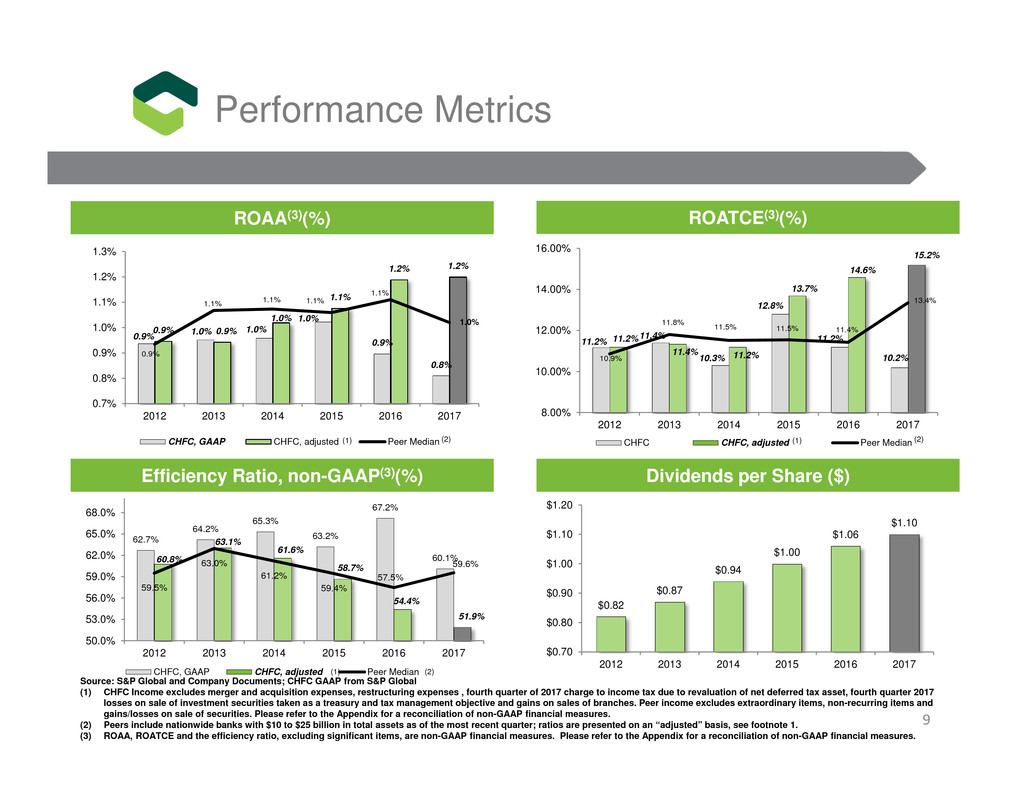
62.7%
64.2%
65.3%
63.2%
67.2%
60.1%60.8%
63.1%
61.6%
58.7%
54.4%
51.9%
59.5%
63.0%
61.2%
59.4%
57.5%
59.6%
50.0%
53.0%
56.0%
59.0%
62.0%
65.0%
68.0%
2012 2013 2014 2015 2016 2017
CHFC, GAAP CHFC, adjusted Peer Median
11.2%
11.4%
10.3%
12.8%
11.2%
10.2%
11.2%
11.4% 11.2%
13.7%
14.6%
15.2%
10.9%
11.8% 11.5% 11.5% 11.4%
13.4%
8.00%
10.00%
12.00%
14.00%
16.00%
2012 2013 2014 2015 2016 2017
CHFC CHFC, adjusted Peer Median
0.9% 1.0%
1.0%
1.0%
0.9%
0.8%
0.9% 0.9%
1.0%
1.1%
1.2% 1.2%
0.9%
1.1% 1.1% 1.1%
1.1%
1.0%
0.7%
0.8%
0.9%
1.0%
1.1%
1.2%
1.3%
2012 2013 2014 2015 2016 2017
CHFC, GAAP CHFC, adjusted Peer Median
ROAA(3)(%)
Performance Metrics
Source: S&P Global and Company Documents; CHFC GAAP from S&P Global
(1) CHFC Income excludes merger and acquisition expenses, restructuring expenses , fourth quarter of 2017 charge to income tax due to revaluation of net deferred tax asset, fourth quarter 2017
losses on sale of investment securities taken as a treasury and tax management objective and gains on sales of branches. Peer income excludes extraordinary items, non-recurring items and
gains/losses on sale of securities. Please refer to the Appendix for a reconciliation of non-GAAP financial measures.
(2) Peers include nationwide banks with $10 to $25 billion in total assets as of the most recent quarter; ratios are presented on an “adjusted” basis, see footnote 1.
(3) ROAA, ROATCE and the efficiency ratio, excluding significant items, are non-GAAP financial measures. Please refer to the Appendix for a reconciliation of non-GAAP financial measures.
ROATCE(3)(%)
Efficiency Ratio, non-GAAP(3)(%)
(2) (2)
(2)
Dividends per Share ($)
(1) (1)
$0.82
$0.87
$0.94
$1.00
$1.06
$1.10
$0.70
$0.80
$0.90
$1.00
$1.10
$1.20
2012 2013 2014 2015 2016 2017
(1)
9
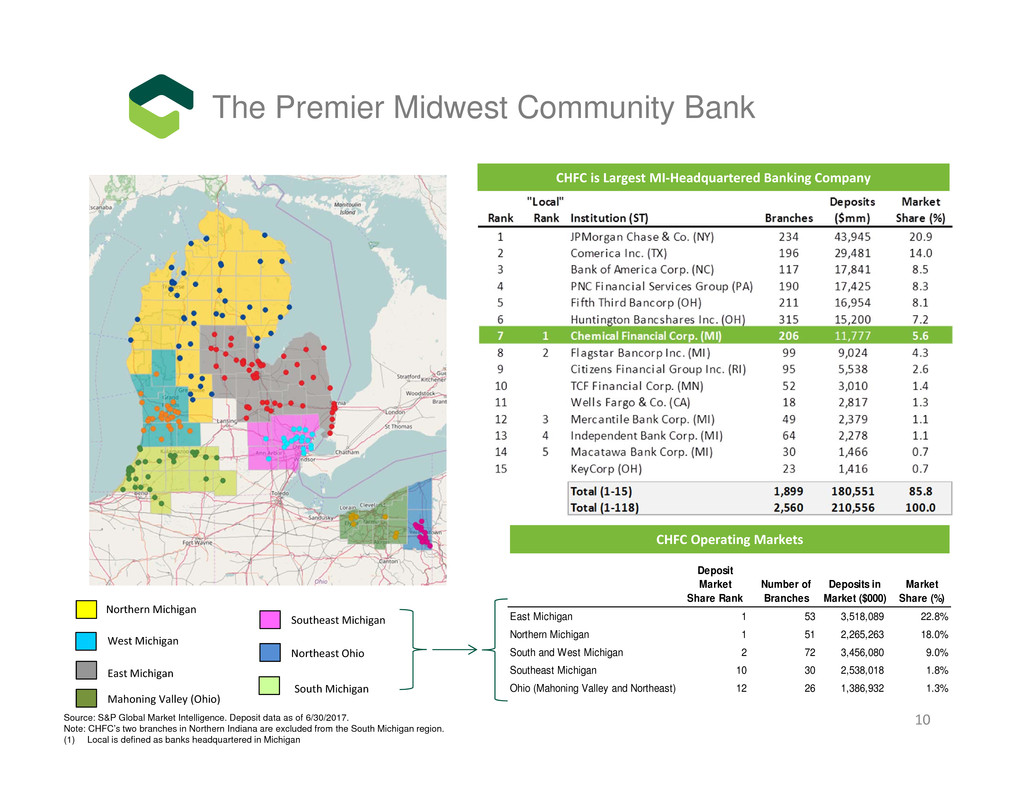
CHFC is Largest MI‐Headquartered Banking Company
CHFC Operating Markets
Source: S&P Global Market Intelligence. Deposit data as of 6/30/2017.
Note: CHFC’s two branches in Northern Indiana are excluded from the South Michigan region.
(1) Local is defined as banks headquartered in Michigan
Northern Michigan
Southeast Michigan
West Michigan
East Michigan
Northeast Ohio
The Premier Midwest Community Bank
South Michigan
Mahoning Valley (Ohio)
Deposit
Market
Share Rank
Number of
Branches
Deposits in
Market ($000)
Market
Share (%)
East Michigan 1 53 3,518,089 22.8%
Northern Michigan 1 51 2,265,263 18.0%
South and West Michigan 2 72 3,456,080 9.0%
Southeast Michigan 10 30 2,538,018 1.8%
Ohio (Mahoning Valley and Northeast) 12 26 1,386,932 1.3%
10
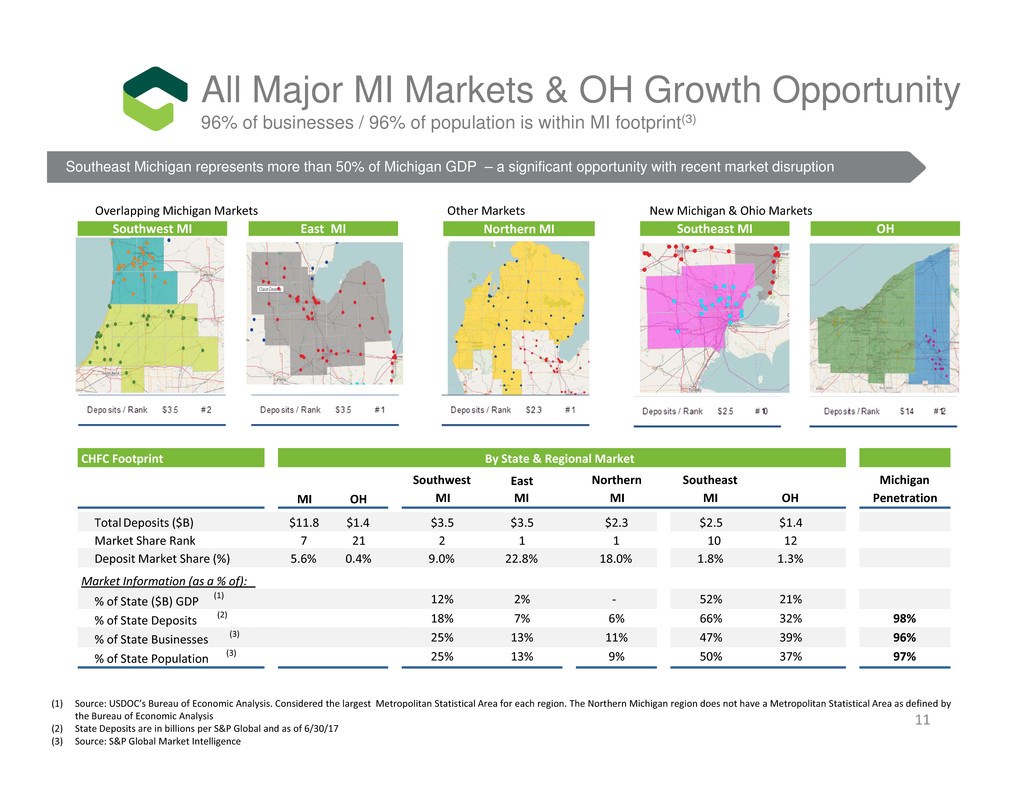
Overlapping Michigan Markets New Michigan & Ohio MarketsOther Markets
Southwest MI East MI Southeast MI OHNorthern MI
(1) Source: USDOC’s Bureau of Economic Analysis. Considered the largest Metropolitan Statistical Area for each region. The Northern Michigan region does not have a Metropolitan Statistical Area as defined by
the Bureau of Economic Analysis
(2) State Deposits are in billions per S&P Global and as of 6/30/17
(3) Source: S&P Global Market Intelligence
All Major MI Markets & OH Growth Opportunity
96% of businesses / 96% of population is within MI footprint(3)
Southeast Michigan represents more than 50% of Michigan GDP – a significant opportunity with recent market disruption
CHFC Footprint By State & Regional Market
MI OH
Southwest
MI
East
MI
Northern
MI
Southeast
MI OH
Michigan
Penetration
TotalDeposits ($B) $11.8 $1.4 $3.5 $3.5 $2.3 $2.5 $1.4
Market Share Rank 7 21 2 1 1 10 12
Deposit Market Share (%) 5.6% 0.4% 9.0% 22.8% 18.0% 1.8% 1.3%
Market Information (as a % of):
% of State ($B) GDP (1) 12% 2% ‐ 52% 21%
% of State Deposits (2) 18% 7% 6% 66% 32% 98%
% of State Businesses (3) 25% 13% 11% 47% 39% 96%
% of State Population (3) 25% 13% 9% 50% 37% 97%
11
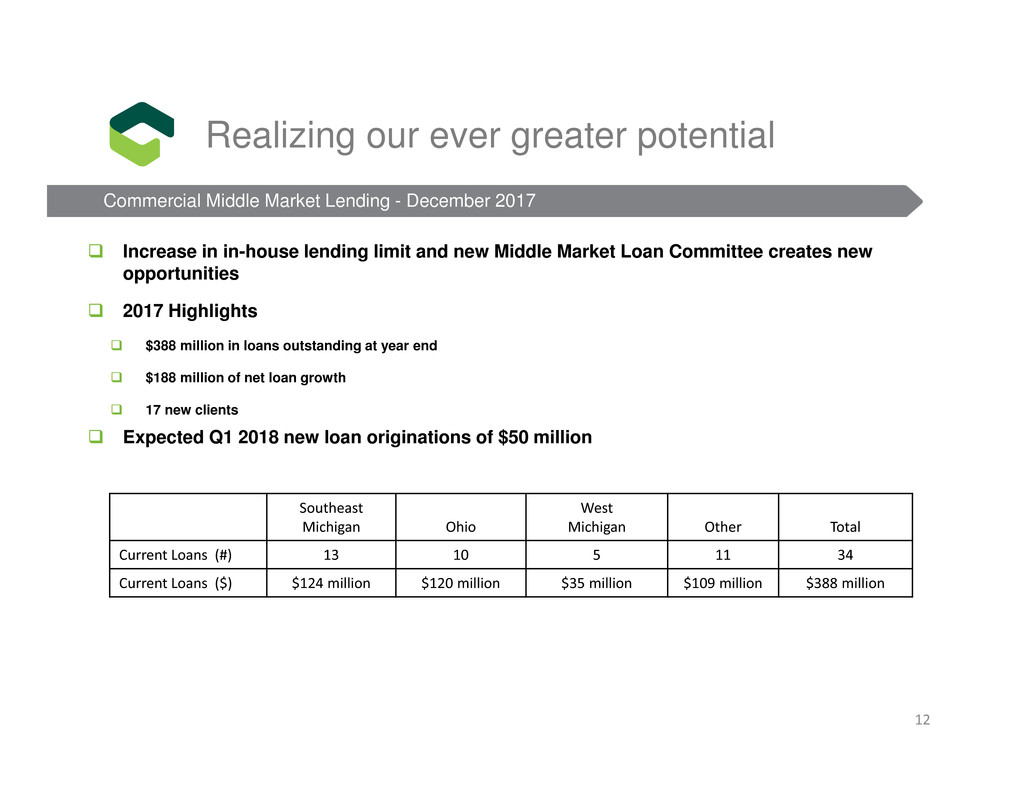
Increase in in-house lending limit and new Middle Market Loan Committee creates new
opportunities
2017 Highlights
$388 million in loans outstanding at year end
$188 million of net loan growth
17 new clients
Expected Q1 2018 new loan originations of $50 million
Realizing our ever greater potential
Commercial Middle Market Lending - December 2017
Southeast
Michigan Ohio
West
Michigan Other Total
Current Loans (#) 13 10 5 11 34
Current Loans ($) $124 million $120 million $35 million $109 million $388 million
12
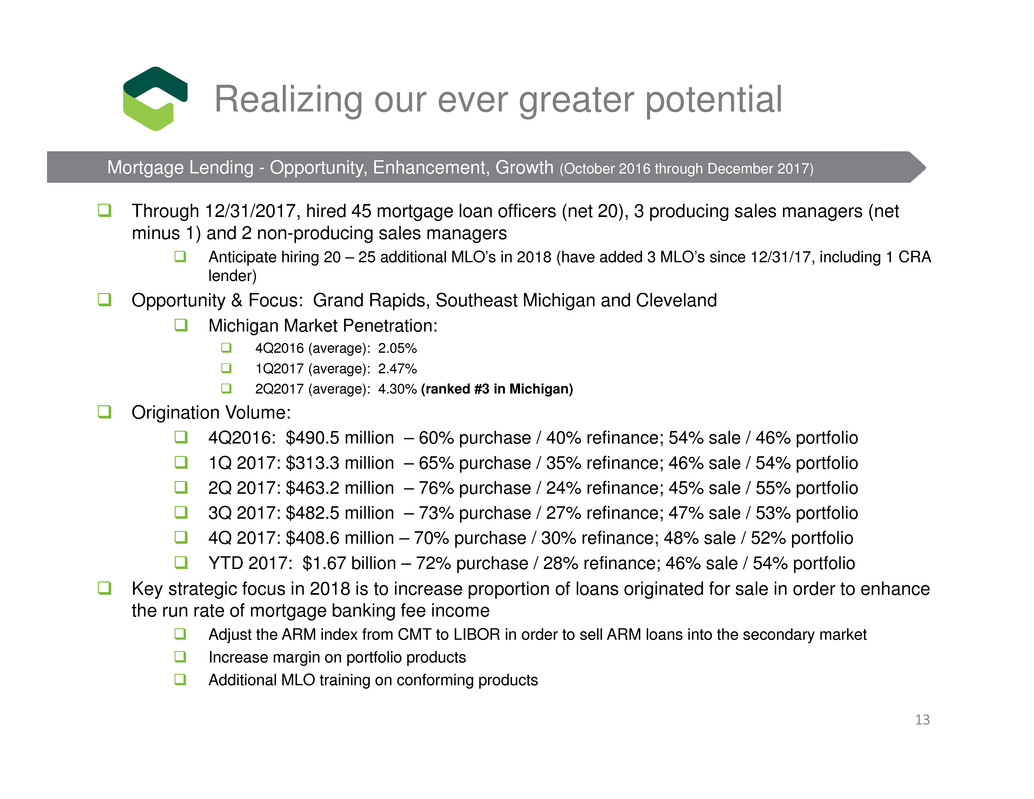
Through 12/31/2017, hired 45 mortgage loan officers (net 20), 3 producing sales managers (net
minus 1) and 2 non-producing sales managers
Anticipate hiring 20 – 25 additional MLO’s in 2018 (have added 3 MLO’s since 12/31/17, including 1 CRA
lender)
Opportunity & Focus: Grand Rapids, Southeast Michigan and Cleveland
Michigan Market Penetration:
4Q2016 (average): 2.05%
1Q2017 (average): 2.47%
2Q2017 (average): 4.30% (ranked #3 in Michigan)
Origination Volume:
4Q2016: $490.5 million – 60% purchase / 40% refinance; 54% sale / 46% portfolio
1Q 2017: $313.3 million – 65% purchase / 35% refinance; 46% sale / 54% portfolio
2Q 2017: $463.2 million – 76% purchase / 24% refinance; 45% sale / 55% portfolio
3Q 2017: $482.5 million – 73% purchase / 27% refinance; 47% sale / 53% portfolio
4Q 2017: $408.6 million – 70% purchase / 30% refinance; 48% sale / 52% portfolio
YTD 2017: $1.67 billion – 72% purchase / 28% refinance; 46% sale / 54% portfolio
Key strategic focus in 2018 is to increase proportion of loans originated for sale in order to enhance
the run rate of mortgage banking fee income
Adjust the ARM index from CMT to LIBOR in order to sell ARM loans into the secondary market
Increase margin on portfolio products
Additional MLO training on conforming products
Realizing our ever greater potential
Mortgage Lending - Opportunity, Enhancement, Growth (October 2016 through December 2017)
13
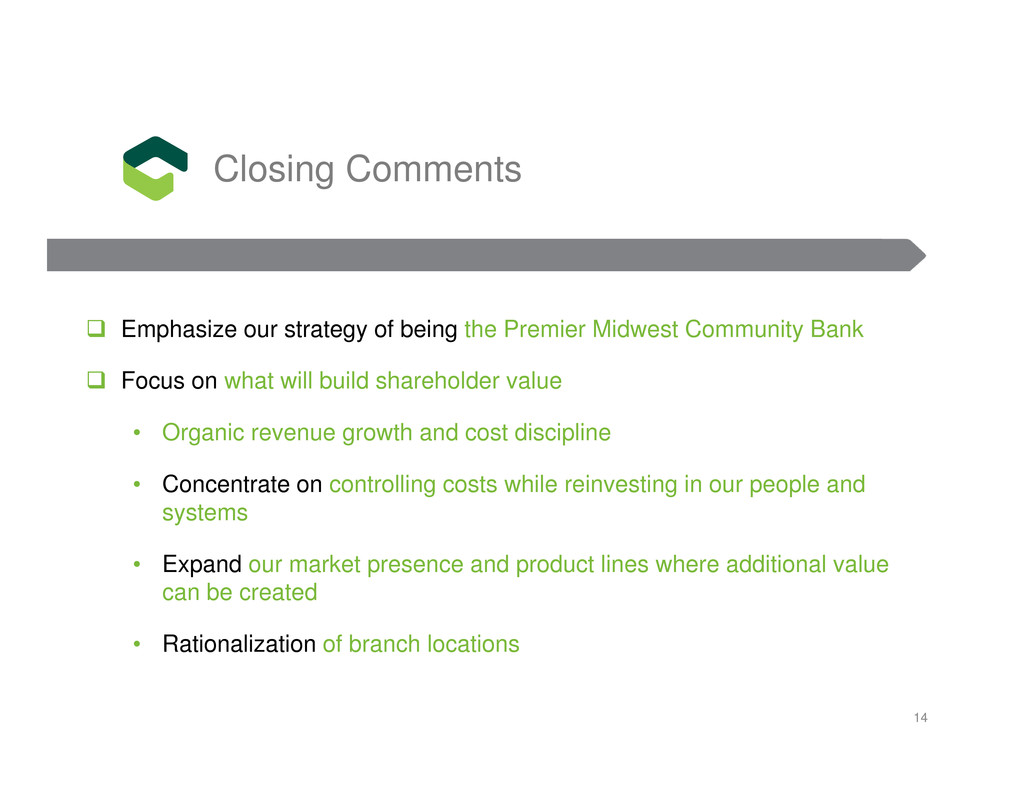
Emphasize our strategy of being the Premier Midwest Community Bank
Focus on what will build shareholder value
• Organic revenue growth and cost discipline
• Concentrate on controlling costs while reinvesting in our people and
systems
• Expand our market presence and product lines where additional value
can be created
• Rationalization of branch locations
Closing Comments
14
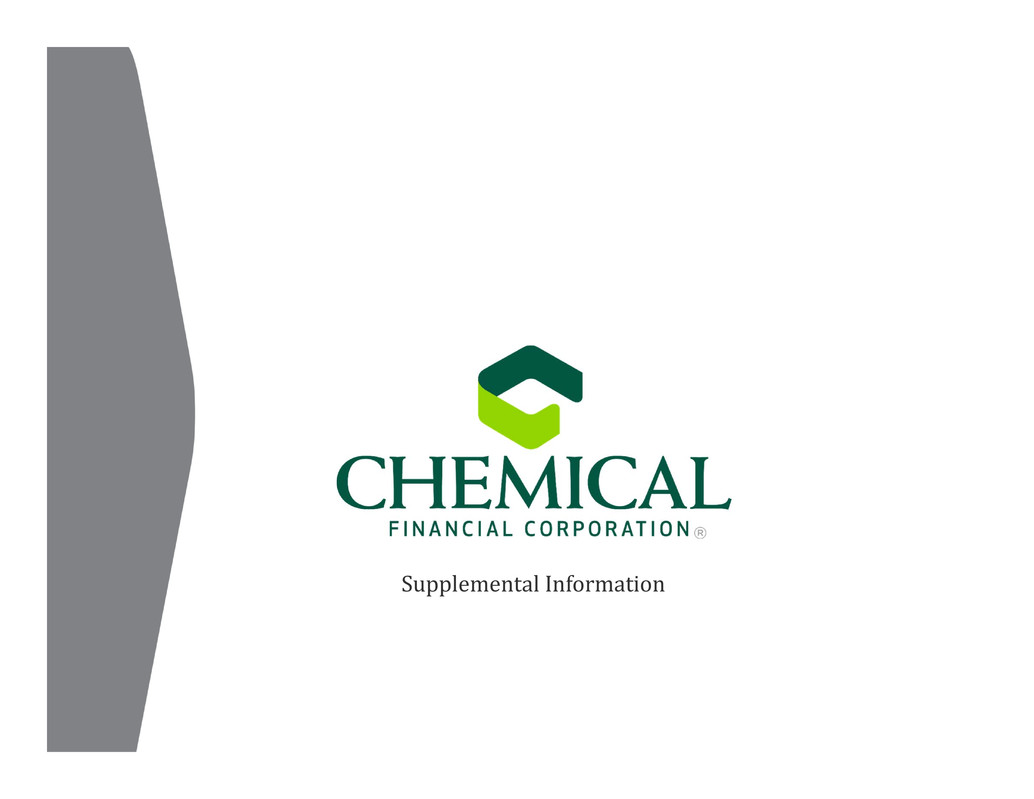
Supplemental Information
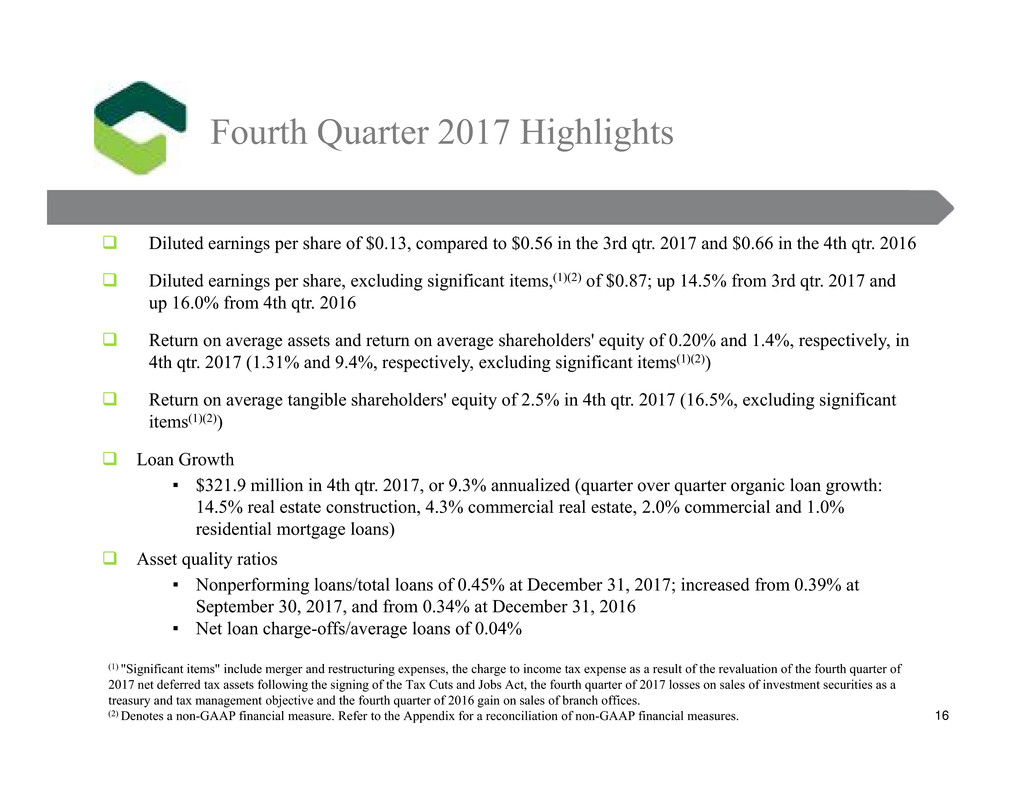
Fourth Quarter 2017 Highlights
Diluted earnings per share of $0.13, compared to $0.56 in the 3rd qtr. 2017 and $0.66 in the 4th qtr. 2016
Diluted earnings per share, excluding significant items,(1)(2) of $0.87; up 14.5% from 3rd qtr. 2017 and
up 16.0% from 4th qtr. 2016
Return on average assets and return on average shareholders' equity of 0.20% and 1.4%, respectively, in
4th qtr. 2017 (1.31% and 9.4%, respectively, excluding significant items(1)(2))
Return on average tangible shareholders' equity of 2.5% in 4th qtr. 2017 (16.5%, excluding significant
items(1)(2))
Loan Growth
▪ $321.9 million in 4th qtr. 2017, or 9.3% annualized (quarter over quarter organic loan growth:
14.5% real estate construction, 4.3% commercial real estate, 2.0% commercial and 1.0%
residential mortgage loans)
Asset quality ratios
▪ Nonperforming loans/total loans of 0.45% at December 31, 2017; increased from 0.39% at
September 30, 2017, and from 0.34% at December 31, 2016
▪ Net loan charge-offs/average loans of 0.04%
(1) "Significant items" include merger and restructuring expenses, the charge to income tax expense as a result of the revaluation of the fourth quarter of
2017 net deferred tax assets following the signing of the Tax Cuts and Jobs Act, the fourth quarter of 2017 losses on sales of investment securities as a
treasury and tax management objective and the fourth quarter of 2016 gain on sales of branch offices.
(2) Denotes a non-GAAP financial measure. Refer to the Appendix for a reconciliation of non-GAAP financial measures. 16
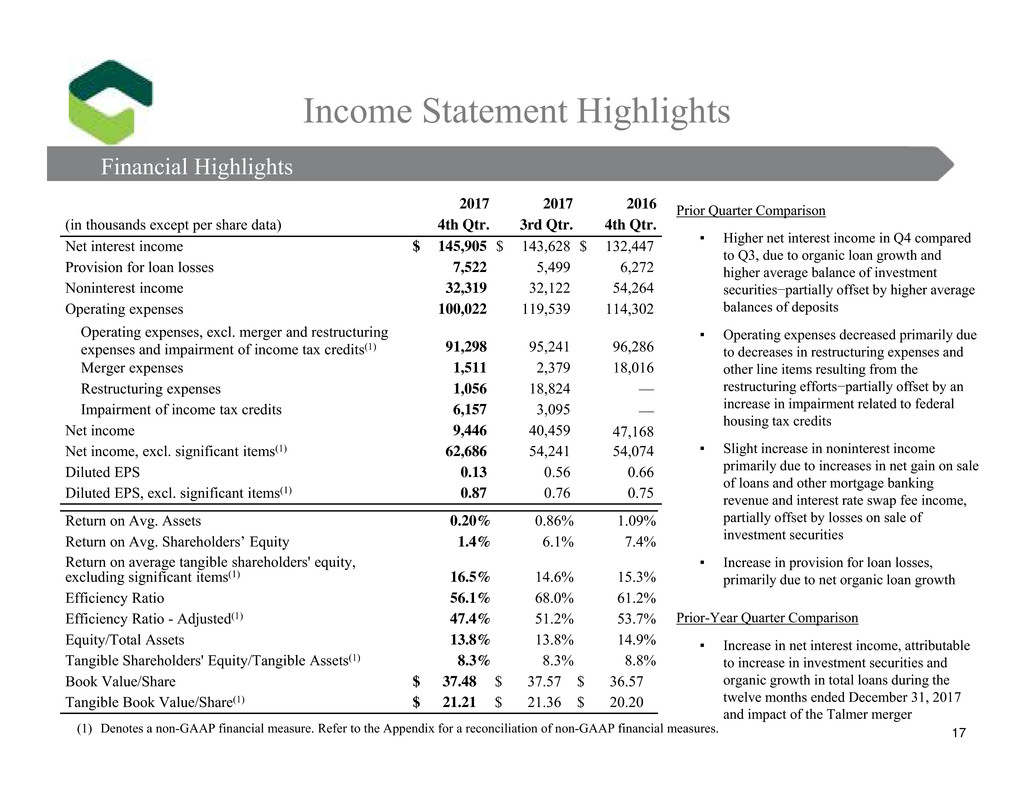
2017 2017 2016
(in thousands except per share data) 4th Qtr. 3rd Qtr. 4th Qtr.
Net interest income $ 145,905 $ 143,628 $ 132,447
Provision for loan losses 7,522 5,499 6,272
Noninterest income 32,319 32,122 54,264
Operating expenses 100,022 119,539 114,302
Operating expenses, excl. merger and restructuring
expenses and impairment of income tax credits(1) 91,298 95,241 96,286
Merger expenses 1,511 2,379 18,016
Restructuring expenses 1,056 18,824 —
Impairment of income tax credits 6,157 3,095 —
Net income 9,446 40,459 47,168
Net income, excl. significant items(1) 62,686 54,241 54,074
Diluted EPS 0.13 0.56 0.66
Diluted EPS, excl. significant items(1) 0.87 0.76 0.75
Return on Avg. Assets 0.20% 0.86% 1.09%
Return on Avg. Shareholders’ Equity 1.4% 6.1% 7.4%
Return on average tangible shareholders' equity,
excluding significant items(1) 16.5% 14.6% 15.3%
Efficiency Ratio 56.1% 68.0% 61.2%
Efficiency Ratio - Adjusted(1) 47.4% 51.2% 53.7%
Equity/Total Assets 13.8% 13.8% 14.9%
Tangible Shareholders' Equity/Tangible Assets(1) 8.3% 8.3% 8.8%
Book Value/Share $ 37.48 $ 37.57 $ 36.57
Tangible Book Value/Share(1) $ 21.21 $ 21.36 $ 20.20
Prior Quarter Comparison
▪ Higher net interest income in Q4 compared
to Q3, due to organic loan growth and
higher average balance of investment
securities−partially offset by higher average
balances of deposits
▪ Operating expenses decreased primarily due
to decreases in restructuring expenses and
other line items resulting from the
restructuring efforts−partially offset by an
increase in impairment related to federal
housing tax credits
▪ Slight increase in noninterest income
primarily due to increases in net gain on sale
of loans and other mortgage banking
revenue and interest rate swap fee income,
partially offset by losses on sale of
investment securities
▪ Increase in provision for loan losses,
primarily due to net organic loan growth
Prior-Year Quarter Comparison
▪ Increase in net interest income, attributable
to increase in investment securities and
organic growth in total loans during the
twelve months ended December 31, 2017
and impact of the Talmer merger
(1) Denotes a non-GAAP financial measure. Refer to the Appendix for a reconciliation of non-GAAP financial measures.
Financial Highlights
Income Statement Highlights
17
Financial Highlights
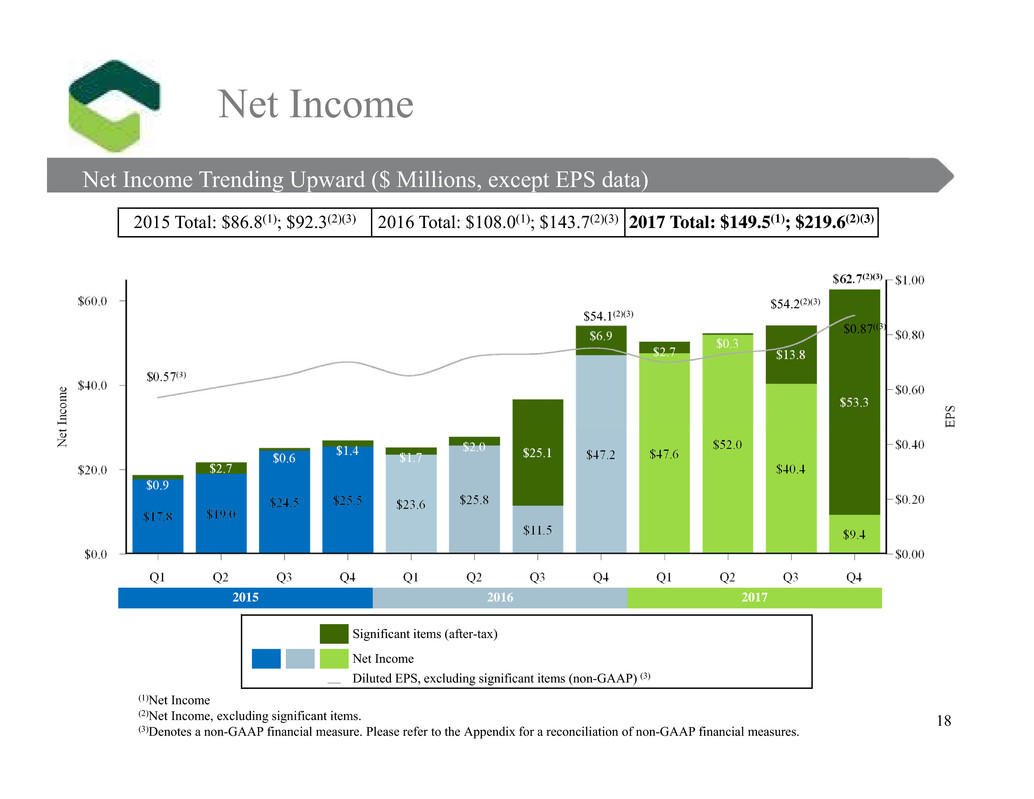
2015 Total: $86.8(1); $92.3(2)(3) 2016 Total: $108.0(1); $143.7(2)(3) 2017 Total: $149.5(1); $219.6(2)(3)
(1)Net Income
(2)Net Income, excluding significant items.
(3)Denotes a non-GAAP financial measure. Please refer to the Appendix for a reconciliation of non-GAAP financial measures.
$62.7(2)(3)
Net Income Trending Upward ($ Millions, except EPS data)
Net Income
$0.57(3)
Net Income Trending Upward ($ Millions, except EPS data)
2015 2016 2017
$54.2(2)(3)
18
$54.1(2)(3)
Significant items (after-tax)
Net Income
__ Diluted EPS, excluding significant items (non-GAAP) (3)
$0.87((3)
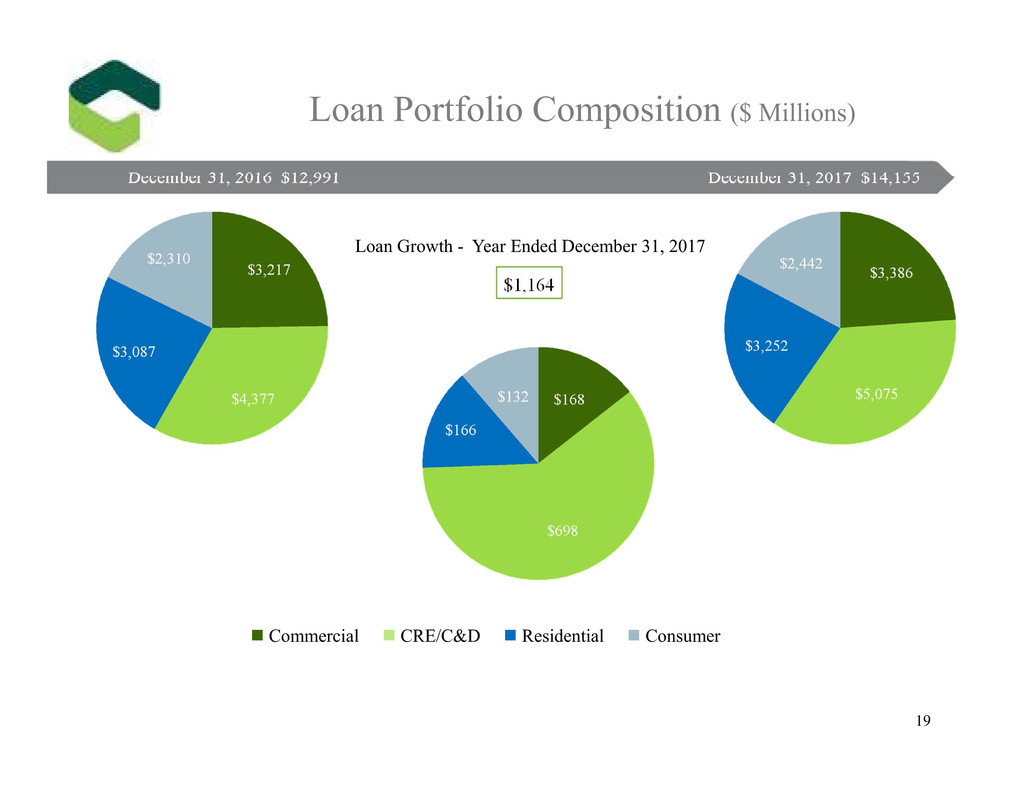
Loan Portfolio Composition ($ Millions)
$1,164
19
December 31, 2016 $12,991 December 31, 2017 $14,155
Total Loan Growth -
Commercial CRE/C&D Residential Consumer
Loan Growth - Year Ended December 31, 2017
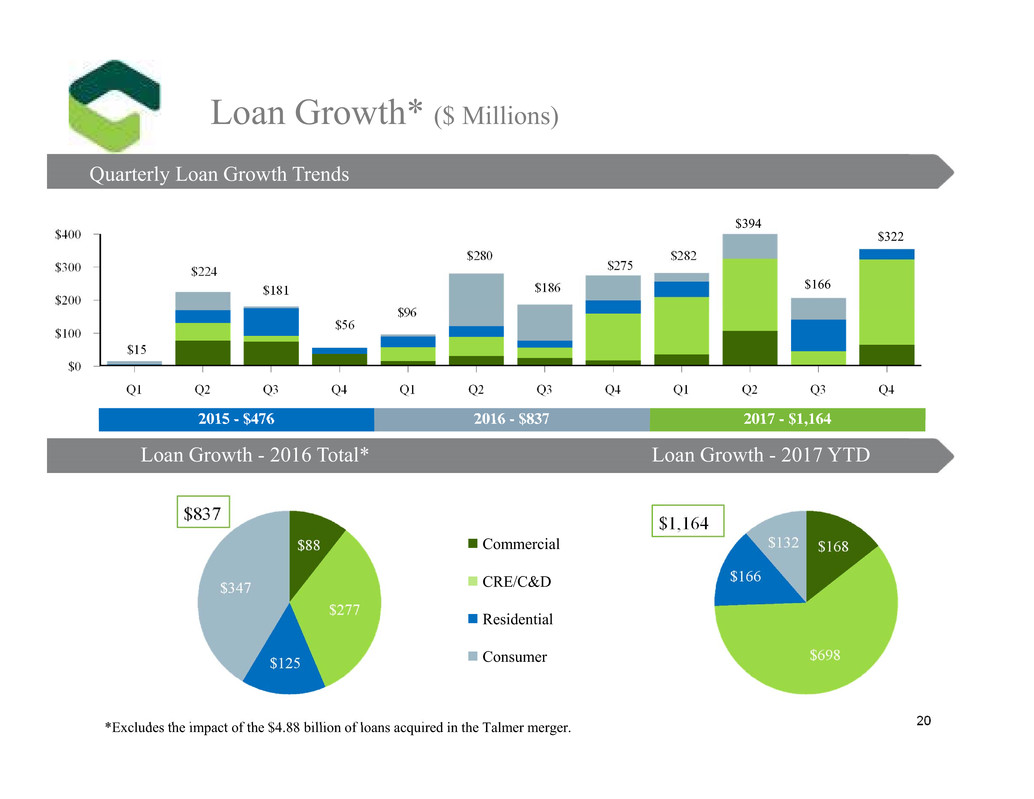
2015 - $476 2016 - $837 2017 - $1,164
$15
$224
$181
$280
$56
$1,164 $837
$96
$186
Loan Growth* ($ Millions)
$275
*Excludes the impact of the $4.88 billion of loans acquired in the Talmer merger.
$282
20
Commercial
CRE/C&D
Residential
Consumer
Loan Growth - 2016 Total* Loan Growth - 2017 YTD
$166
$394
Quarterly Loan Growth Trends
$322
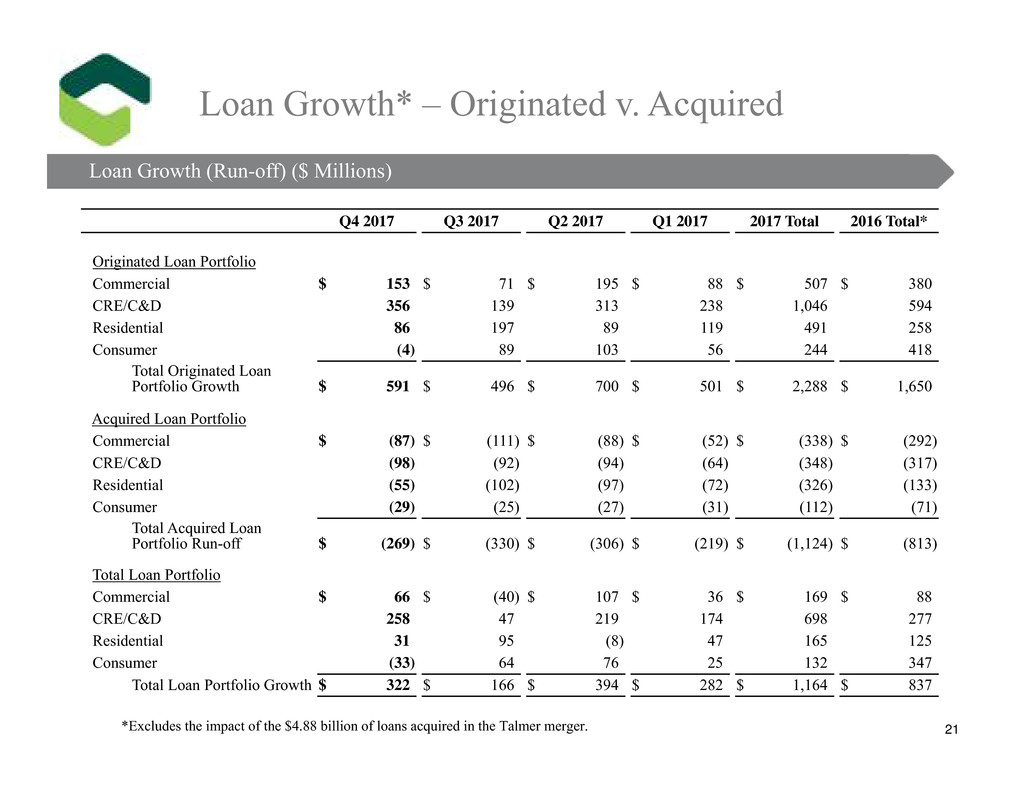
Q4 2017 Q3 2017 Q2 2017 Q1 2017 2017 Total 2016 Total*
Originated Loan Portfolio
Commercial $ 153 $ 71 $ 195 $ 88 $ 507 $ 380
CRE/C&D 356 139 313 238 1,046 594
Residential 86 197 89 119 491 258
Consumer (4) 89 103 56 244 418
Total Originated Loan
Portfolio Growth $ 591 $ 496 $ 700 $ 501 $ 2,288 $ 1,650
Acquired Loan Portfolio
Commercial $ (87) $ (111) $ (88) $ (52) $ (338) $ (292)
CRE/C&D (98) (92) (94) (64) (348) (317)
Residential (55) (102) (97) (72) (326) (133)
Consumer (29) (25) (27) (31) (112) (71)
Total Acquired Loan
Portfolio Run-off $ (269) $ (330) $ (306) $ (219) $ (1,124) $ (813)
Total Loan Portfolio
Commercial $ 66 $ (40) $ 107 $ 36 $ 169 $ 88
CRE/C&D 258 47 219 174 698 277
Residential 31 95 (8) 47 165 125
Consumer (33) 64 76 25 132 347
Total Loan Portfolio Growth $ 322 $ 166 $ 394 $ 282 $ 1,164 $ 837
Loan Growth (Run-off) ($ Millions)
Loan Growth* – Originated v. Acquired
*Excludes the impact of the $4.88 billion of loans acquired in the Talmer merger. 21
Loan Growth (Run-off) ($ Millions)
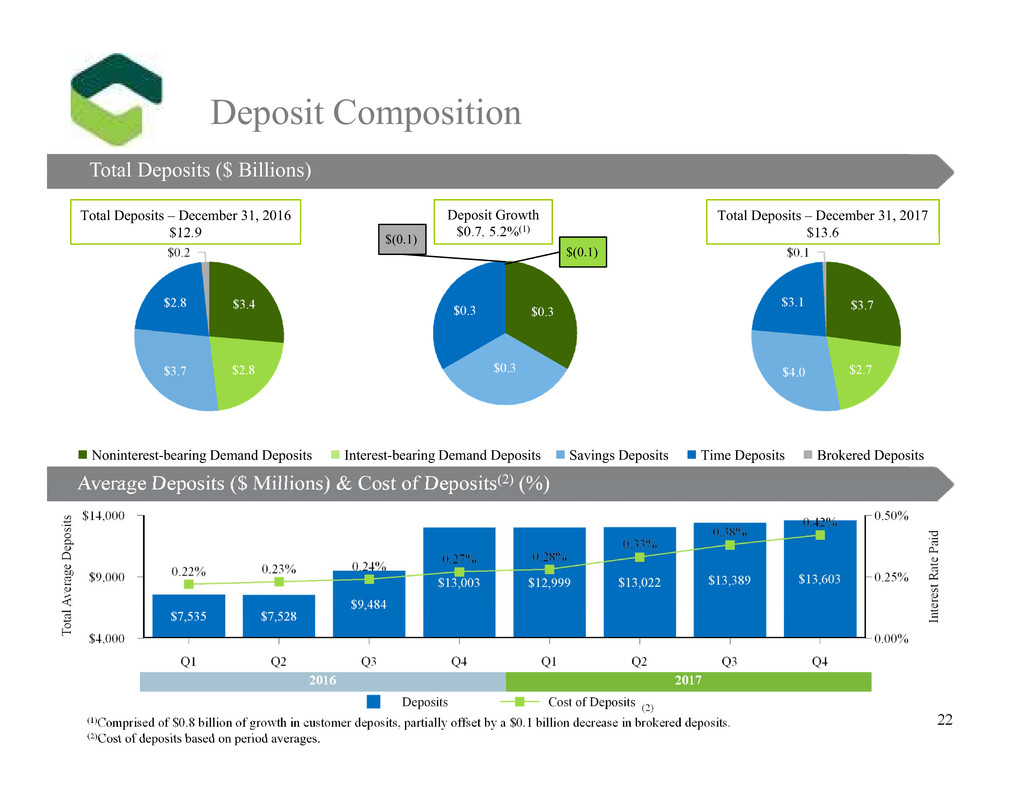
(1)Comprised of $0.8 billion of growth in customer deposits, partially offset by a $0.1 billion decrease in brokered deposits.
(2)Cost of deposits based on period averages.
Total Deposits – December 31, 2016
$12.9
Total Deposits – December 31, 2017
$13.6
Deposit Growth
$0.7, 5.2%(1)
Total Deposits ($ Billions)
Deposit Composition
(2)
2016 2017
22
Total Deposits ($ Billions)
Average Deposits ($ Millions) & Cost of Deposits(2) (%)
Noninterest-bearing Demand Deposits Interest-bearing Demand Deposits Savings Deposits Time Deposits Brokered Deposits
$(0.1)
$(0.1)
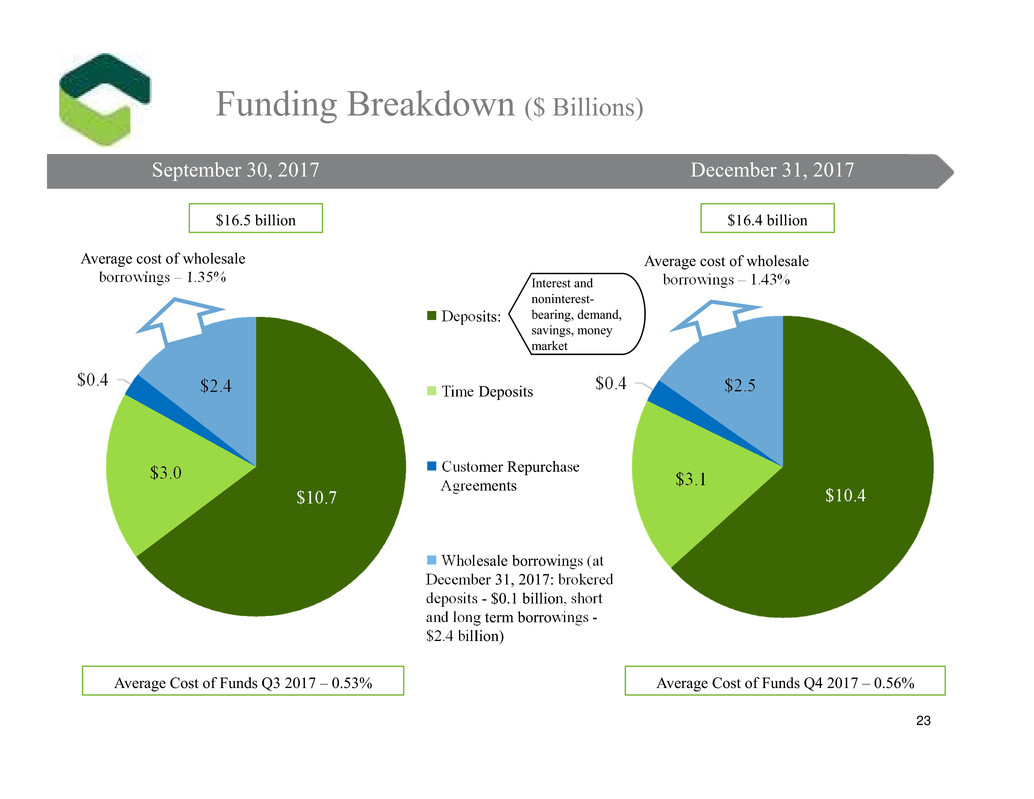
Average Cost of Funds Q4 2017 – 0.56% Average Cost of Funds Q3 2017 – 0.53%
$16.5 billion $16.4 billion
Average cost of wholesale
borrowings – 1.43%
Average cost of wholesale
borrowings – 1.35%
Funding Breakdown ($ Billions)
23
September 30, 2017 December 31, 2017
Deposits:
Time Deposits
Customer Repurchase
Agreements
Wholesale borrowings (at
December 31, 2017: brokered
deposits - $0.1 billion, short
and long term borrowings -
$2.4 billion)
Interest and
noninterest-
bearing, demand,
savings, money
market
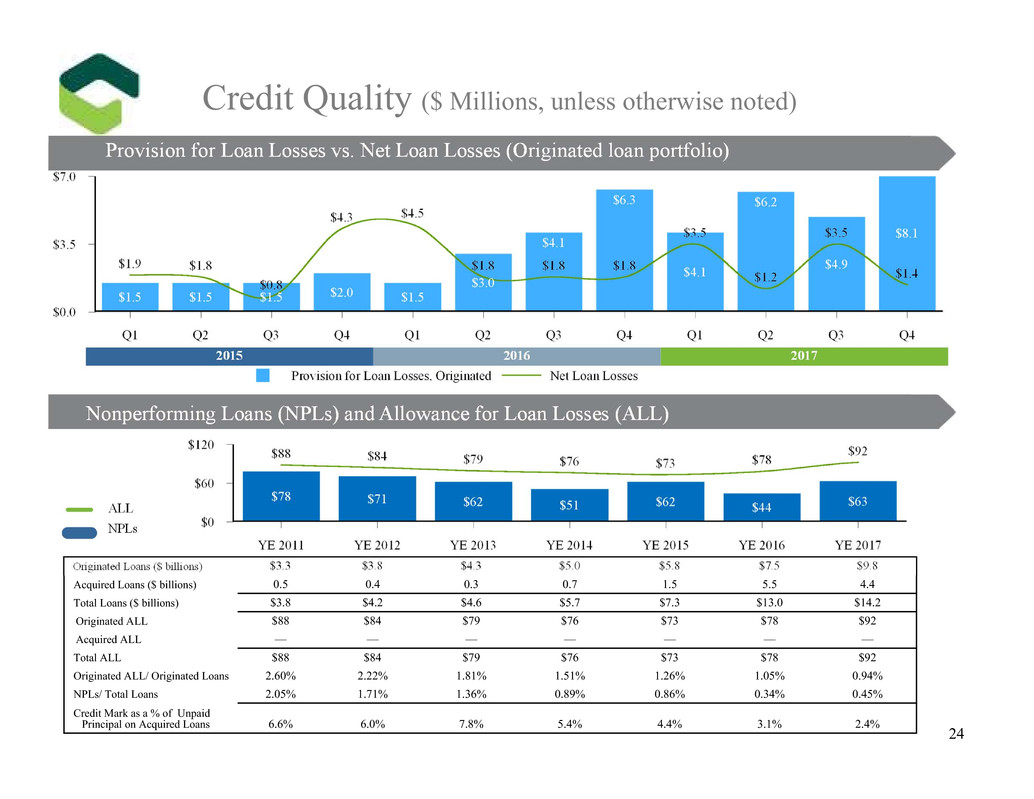
ALL
NPLs
2015 2016 2017
Originated Loans ($ billions) $3.3 $3.8 $4.3 $5.0 $5.8 $7.5 $9.8
Acquired Loans ($ billions) 0.5 0.4 0.3 0.7 1.5 5.5 4.4
Total Loans ($ billions) $3.8 $4.2 $4.6 $5.7 $7.3 $13.0 $14.2
Originated ALL $88 $84 $79 $76 $73 $78 $92
Acquired ALL — — — — — — —
Total ALL $88 $84 $79 $76 $73 $78 $92
Originated ALL/ Originated Loans 2.60% 2.22% 1.81% 1.51% 1.26% 1.05% 0.94%
NPLs/ Total Loans 2.05% 1.71% 1.36% 0.89% 0.86% 0.34% 0.45%
Credit Mark as a % of Unpaid
Principal on Acquired Loans 6.6% 6.0% 7.8% 5.4% 4.4% 3.1% 2.4%
Provision for Loan Losses vs. Net Loan Losses
Credit Quality ($ Millions, unless otherwise noted)
Provision for Loan Losses vs. Net Loan Losses (Originated loan portfolio)
Nonperforming Loans (NPLs) and Allowance for Loan Losses (ALL)
24
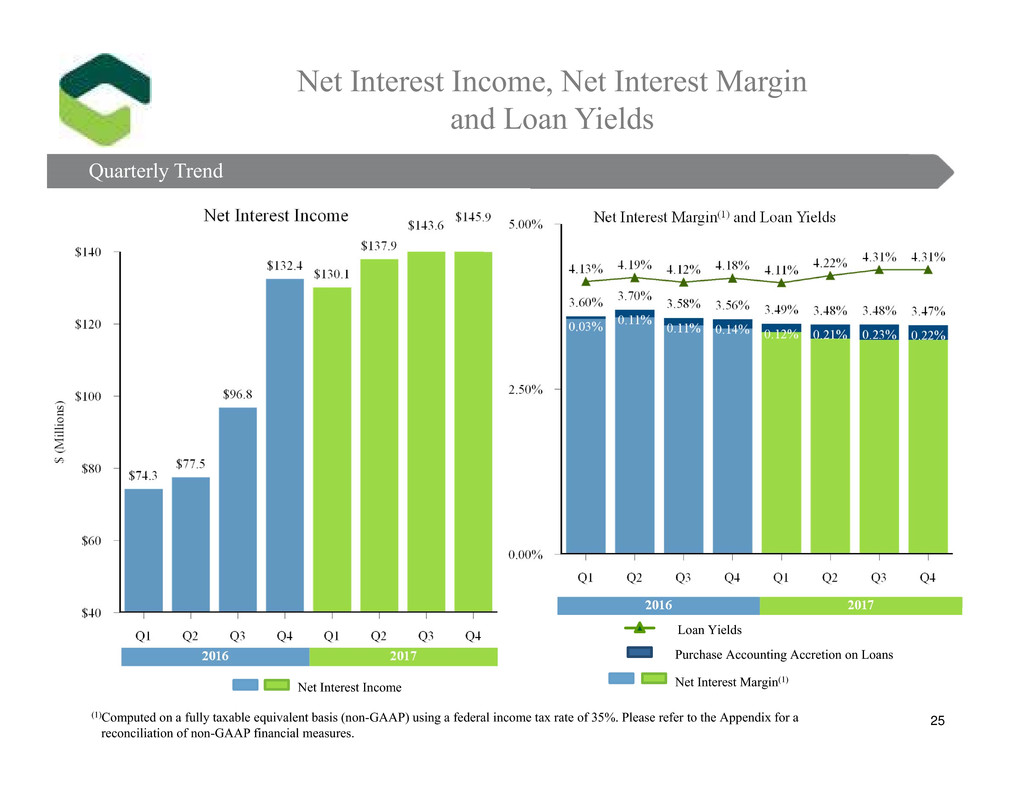
Net Interest Margin(1) and Loan Yields
Net Interest Margin(1)
Purchase Accounting Accretion on Loans
Loan Yields
Net Interest Income
(Quarterly Trend)
Net Interest Income, Net Interest Margin
and Loan Yields
(1)Computed on a fully taxable equivalent basis (non-GAAP) using a federal income tax rate of 35%. Please refer to the Appendix for a
reconciliation of non-GAAP financial measures.
25
Quarterly Tre
2016 2017
2016 2017
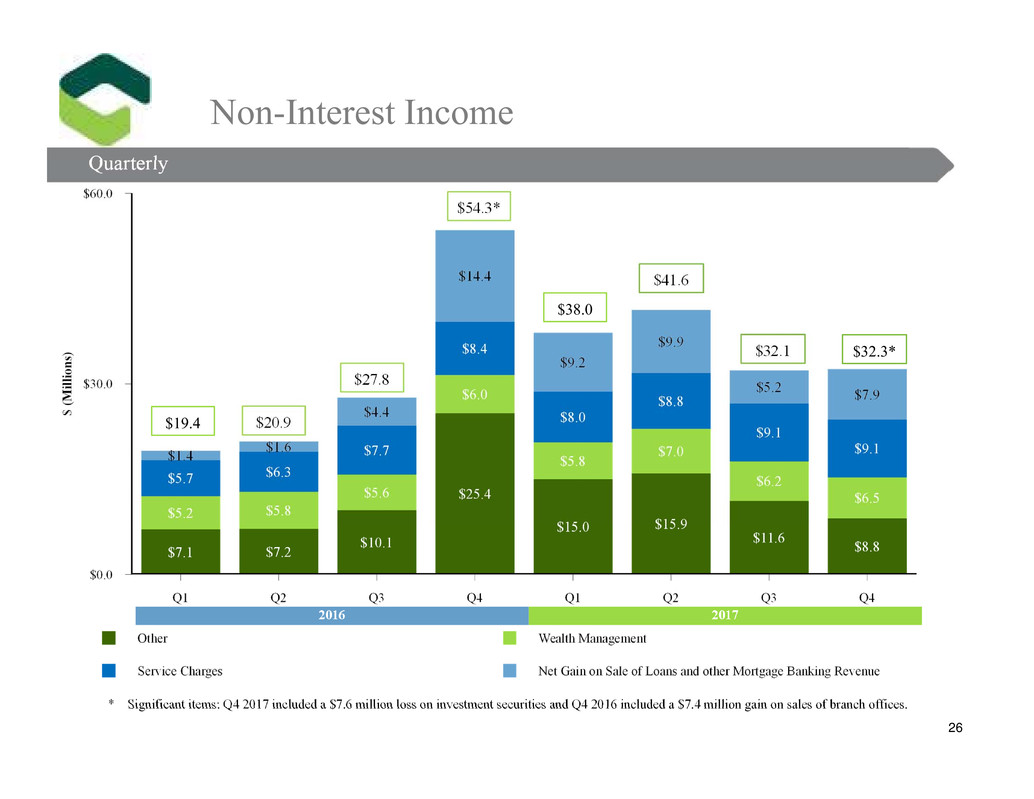
$20.9
$32.1
Quarterly
Non-Interest Income
* Significant items: Q4 2017 included a $7.6 million loss on investment securities and Q4 2016 included a $7.4 million gain on sales of branch offices.
$41.6
$27.8
$54.3*
26
Quarterly
2016 2017
$38.0
$19.4
$32.3*
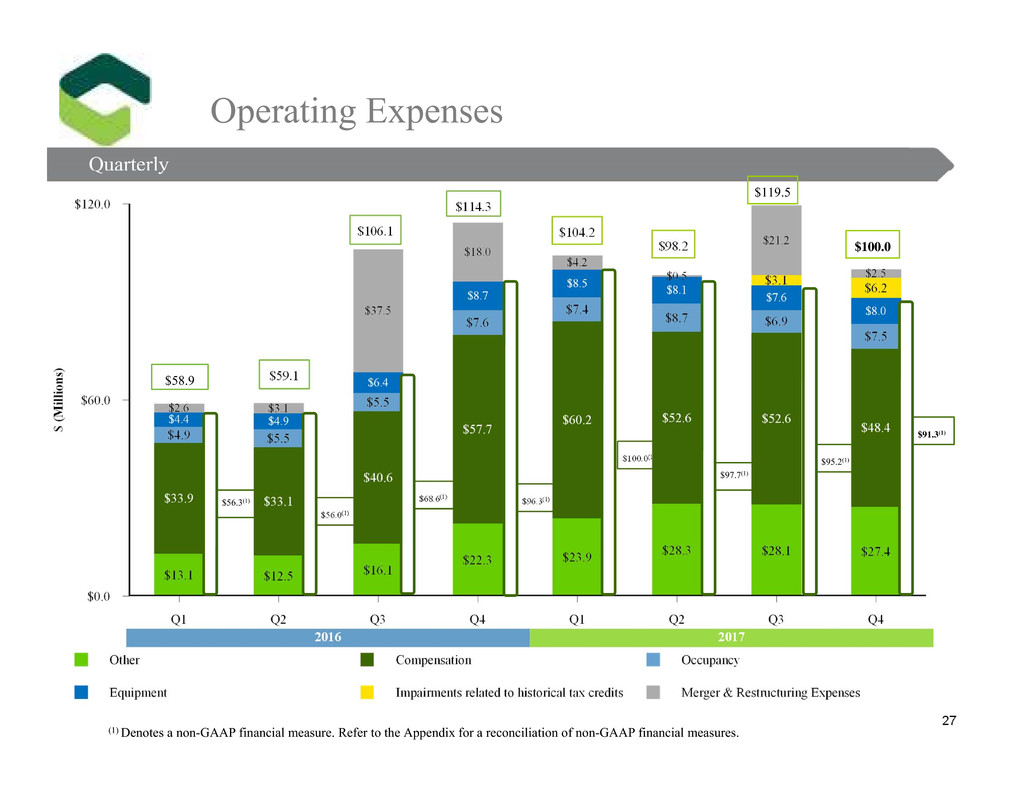
$68.6(1)
$106.1
$56.0(1)
$59.1
$96.3(1)
$114.3
Quarterly
Operating Expenses
$98.2
$100.0(1)
27
Quarterly
2016 2017
$104.2
$97.7(1)
$95.2(1)
$119.5
(1) Denotes a non-GAAP financial measure. Refer to the Appendix for a reconciliation of non-GAAP financial measures.
$56.3(1)
$58.9
$100.0
$91.3(1)
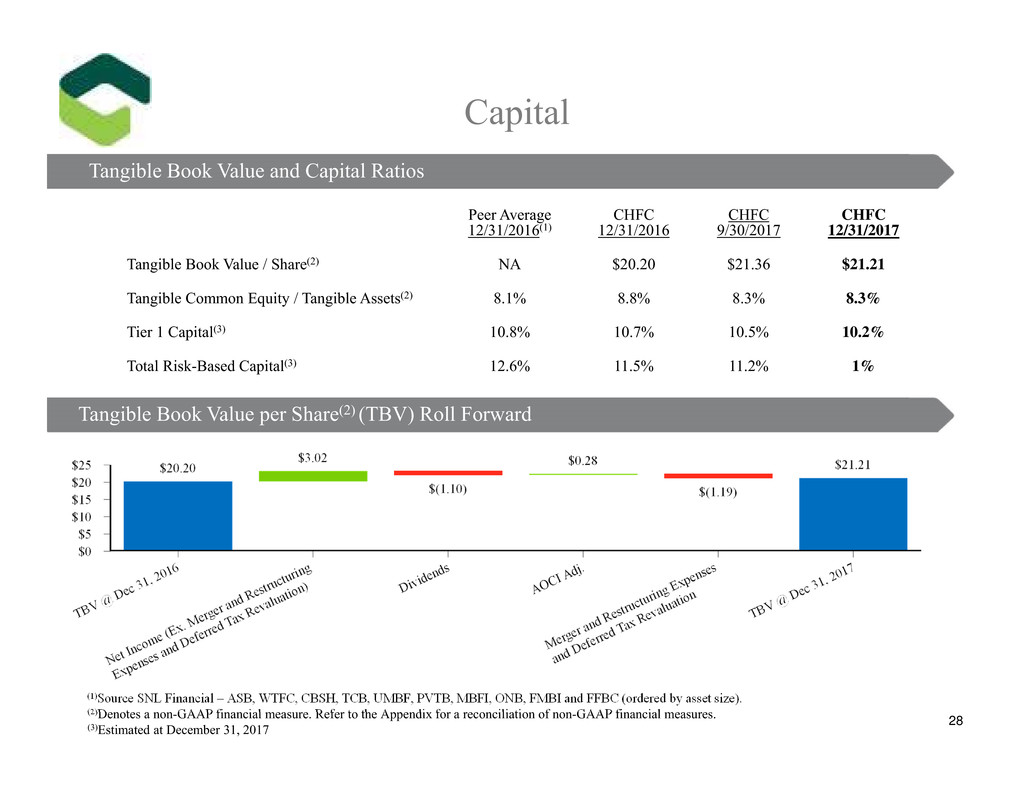
Peer Average
12/31/2016(1)
CHFC
12/31/2016
CHFC
9/30/2017
CHFC
12/31/2017
Tangible Book Value / Share(2) NA $20.20 $21.36 $21.21
Tangible Common Equity / Tangible Assets(2) 8.1% 8.8% 8.3% 8.3%
Tier 1 Capital(3) 10.8% 10.7% 10.5% 10.2%
Total Risk-Based Capital(3) 12.6% 11.5% 11.2% 1%
Capital
(1)Source SNL Financial – ASB, WTFC, CBSH, TCB, UMBF, PVTB, MBFI, ONB, FMBI and FFBC (ordered by asset size).
(2)Denotes a non-GAAP financial measure. Refer to the Appendix for a reconciliation of non-GAAP financial measures.
(3)Estimated at December 31, 2017
Tangible Book Value and Capital Ratios
Tangible Book Value per Share(2) (TBV) Roll Forward
28

0.00
0.20
0.40
0.60
0.80
1.00
1.20
$
P
e
r
S
h
a
r
e
Performance & Expectations Analyst Consensus
Consistent growth and performance for shareholders through economic cycles
Mergers have created the opportunity to strengthen the foundation for delivering
sustainable, strong EPS growth into the future
Consensus EPS Consensus Dividend
SNL Core EPS Common Dividend
29
Consistent EPS Growth Performance
Source: S&P Global Market Intelligence analyst consensus estimates as of 1/30/2018
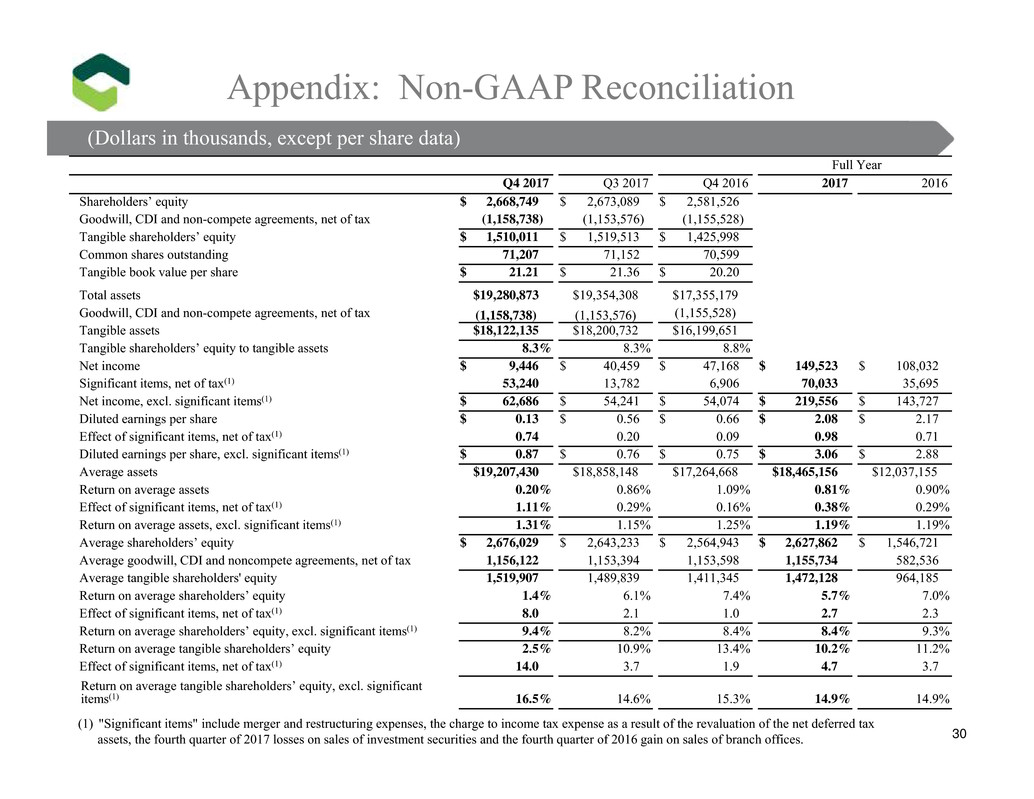
Full Year
Q4 2017 Q3 2017 Q4 2016 2017 2016
Shareholders’ equity $ 2,668,749 $ 2,673,089 $ 2,581,526
Goodwill, CDI and non-compete agreements, net of tax (1,158,738) (1,153,576) (1,155,528)
Tangible shareholders’ equity $ 1,510,011 $ 1,519,513 $ 1,425,998
Common shares outstanding 71,207 71,152 70,599
Tangible book value per share $ 21.21 $ 21.36 $ 20.20
Total assets $19,280,873 $19,354,308 $17,355,179
Goodwill, CDI and non-compete agreements, net of tax (1,158,738) (1,153,576) (1,155,528)
Tangible assets $18,122,135 $18,200,732 $16,199,651
Tangible shareholders’ equity to tangible assets 8.3% 8.3% 8.8%
Net income $ 9,446 $ 40,459 $ 47,168 $ 149,523 $ 108,032
Significant items, net of tax(1) 53,240 13,782 6,906 70,033 35,695
Net income, excl. significant items(1) $ 62,686 $ 54,241 $ 54,074 $ 219,556 $ 143,727
Diluted earnings per share $ 0.13 $ 0.56 $ 0.66 $ 2.08 $ 2.17
Effect of significant items, net of tax(1) 0.74 0.20 0.09 0.98 0.71
Diluted earnings per share, excl. significant items(1) $ 0.87 $ 0.76 $ 0.75 $ 3.06 $ 2.88
Average assets $19,207,430 $18,858,148 $17,264,668 $18,465,156 $12,037,155
Return on average assets 0.20% 0.86% 1.09% 0.81% 0.90%
Effect of significant items, net of tax(1) 1.11% 0.29% 0.16% 0.38% 0.29%
Return on average assets, excl. significant items(1) 1.31% 1.15% 1.25% 1.19% 1.19%
Average shareholders’ equity $ 2,676,029 $ 2,643,233 $ 2,564,943 $ 2,627,862 $ 1,546,721
Average goodwill, CDI and noncompete agreements, net of tax 1,156,122 1,153,394 1,153,598 1,155,734 582,536
Average tangible shareholders' equity 1,519,907 1,489,839 1,411,345 1,472,128 964,185
Return on average shareholders’ equity 1.4% 6.1% 7.4% 5.7% 7.0%
Effect of significant items, net of tax(1) 8.0 2.1 1.0 2.7 2.3
Return on average shareholders’ equity, excl. significant items(1) 9.4% 8.2% 8.4% 8.4% 9.3%
Return on average tangible shareholders’ equity 2.5% 10.9% 13.4% 10.2% 11.2%
Effect of significant items, net of tax(1) 14.0 3.7 1.9 4.7 3.7
Return on average tangible shareholders’ equity, excl. significant
items(1) 16.5% 14.6% 15.3% 14.9% 14.9%
(Dollars in thousands, except per share data)
Appendix: Non-GAAP Reconciliation
30
lars in thousands, exce t per share data)
(1) "Significant items" include merger and restructuring expenses, the charge to income tax expense as a result of the revaluation of the net deferred tax
assets, the fourth quarter of 2017 losses on sales of investment securities and the fourth quarter of 2016 gain on sales of branch offices.
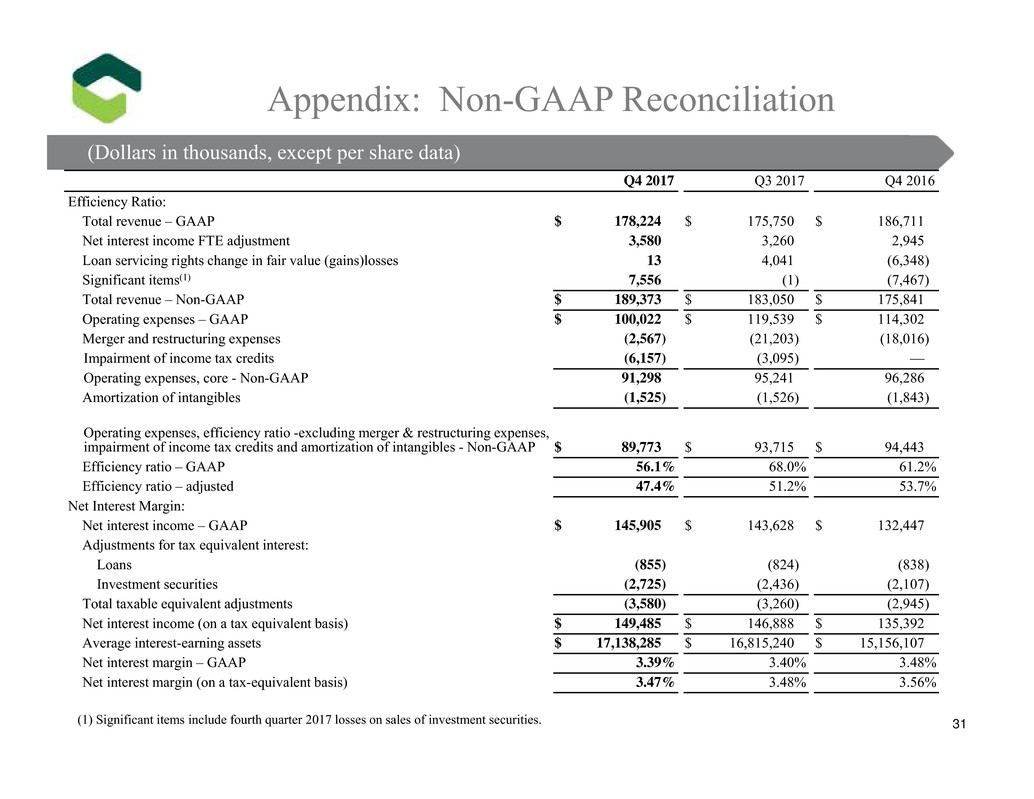
Q4 2017 Q3 2017 Q4 2016
Efficiency Ratio:
Total revenue – GAAP $ 178,224 $ 175,750 $ 186,711
Net interest income FTE adjustment 3,580 3,260 2,945
Loan servicing rights change in fair value (gains)losses 13 4,041 (6,348)
Significant items(1) 7,556 (1) (7,467)
Total revenue – Non-GAAP $ 189,373 $ 183,050 $ 175,841
Operating expenses – GAAP $ 100,022 $ 119,539 $ 114,302
Merger and restructuring expenses (2,567) (21,203) (18,016)
Impairment of income tax credits (6,157) (3,095) —
Operating expenses, core - Non-GAAP 91,298 95,241 96,286
Amortization of intangibles (1,525) (1,526) (1,843)
Operating expenses, efficiency ratio -excluding merger & restructuring expenses,
impairment of income tax credits and amortization of intangibles - Non-GAAP $ 89,773 $ 93,715 $ 94,443
Efficiency ratio – GAAP 56.1% 68.0% 61.2%
Efficiency ratio – adjusted 47.4% 51.2% 53.7%
Net Interest Margin:
Net interest income – GAAP $ 145,905 $ 143,628 $ 132,447
Adjustments for tax equivalent interest:
Loans (855) (824) (838)
Investment securities (2,725) (2,436) (2,107)
Total taxable equivalent adjustments (3,580) (3,260) (2,945)
Net interest income (on a tax equivalent basis) $ 149,485 $ 146,888 $ 135,392
Average interest-earning assets $ 17,138,285 $ 16,815,240 $ 15,156,107
Net interest margin – GAAP 3.39% 3.40% 3.48%
Net interest margin (on a tax-equivalent basis) 3.47% 3.48% 3.56%
(Dollars in thousands, except per share data)
Appendix: Non-GAAP Reconciliation
31
lars in thousands, exce t per share data)
(1) Significant items include fourth quarter 2017 losses on sales of investment securities.
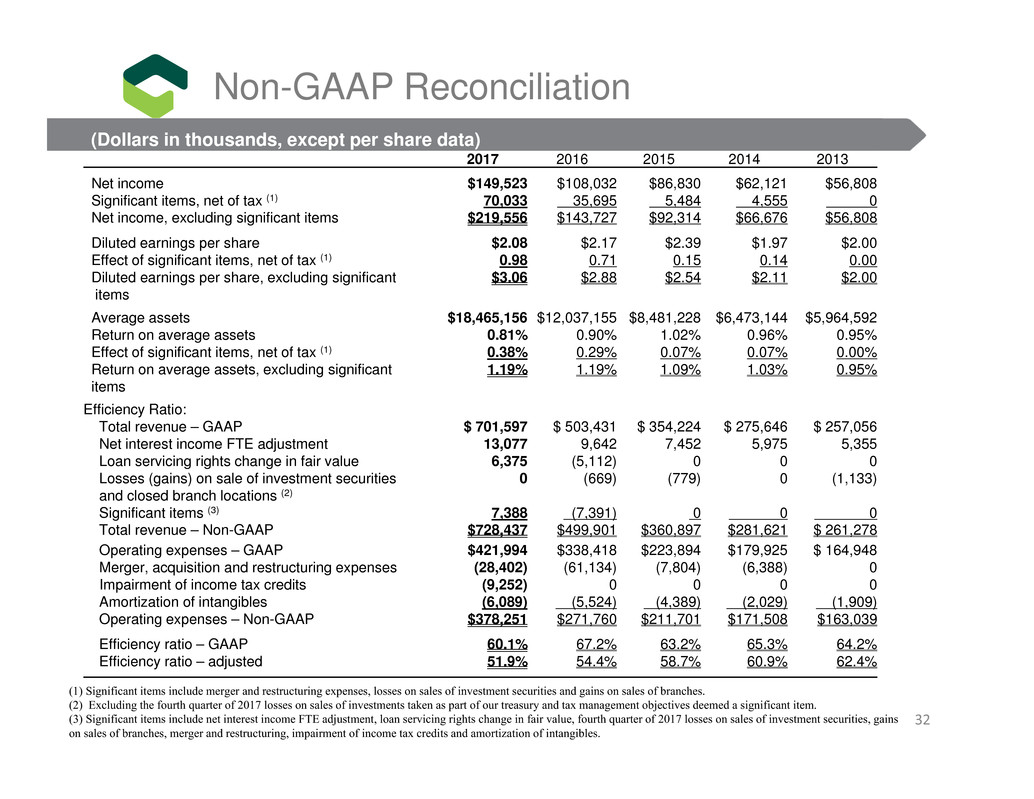
2017 2016 2015 2014 2013
Net income $149,523 $108,032 $86,830 $62,121 $56,808
Significant items, net of tax (1) 70,033 35,695 5,484 4,555 0
Net income, excluding significant items $219,556 $143,727 $92,314 $66,676 $56,808
Diluted earnings per share $2.08 $2.17 $2.39 $1.97 $2.00
Effect of significant items, net of tax (1) 0.98 0.71 0.15 0.14 0.00
Diluted earnings per share, excluding significant
items
$3.06 $2.88 $2.54 $2.11 $2.00
Average assets $18,465,156 $12,037,155 $8,481,228 $6,473,144 $5,964,592
Return on average assets 0.81% 0.90% 1.02% 0.96% 0.95%
Effect of significant items, net of tax (1) 0.38% 0.29% 0.07% 0.07% 0.00%
Return on average assets, excluding significant
items
1.19% 1.19% 1.09% 1.03% 0.95%
Efficiency Ratio:
Total revenue – GAAP $ 701,597 $ 503,431 $ 354,224 $ 275,646 $ 257,056
Net interest income FTE adjustment 13,077 9,642 7,452 5,975 5,355
Loan servicing rights change in fair value 6,375 (5,112) 0 0 0
Losses (gains) on sale of investment securities
and closed branch locations (2)
0 (669) (779) 0 (1,133)
Significant items (3) 7,388 (7,391) 0 0 0
Total revenue – Non-GAAP $728,437 $499,901 $360,897 $281,621 $ 261,278
Operating expenses – GAAP $421,994 $338,418 $223,894 $179,925 $ 164,948
Merger, acquisition and restructuring expenses (28,402) (61,134) (7,804) (6,388) 0
Impairment of income tax credits (9,252) 0 0 0 0
Amortization of intangibles (6,089) (5,524) (4,389) (2,029) (1,909)
Operating expenses – Non-GAAP $378,251 $271,760 $211,701 $171,508 $163,039
Efficiency ratio – GAAP 60.1% 67.2% 63.2% 65.3% 64.2%
Efficiency ratio – adjusted 51.9% 54.4% 58.7% 60.9% 62.4%
Non-GAAP Reconciliation
(Dollars in thousands, except per share data)
(1) Significant items include merger and restructuring expenses, losses on sales of investment securities and gains on sales of branches.
(2) Excluding the fourth quarter of 2017 losses on sales of investments taken as part of our treasury and tax management objectives deemed a significant item.
(3) Significant items include net interest income FTE adjustment, loan servicing rights change in fair value, fourth quarter of 2017 losses on sales of investment securities, gains
on sales of branches, merger and restructuring, impairment of income tax credits and amortization of intangibles.
32
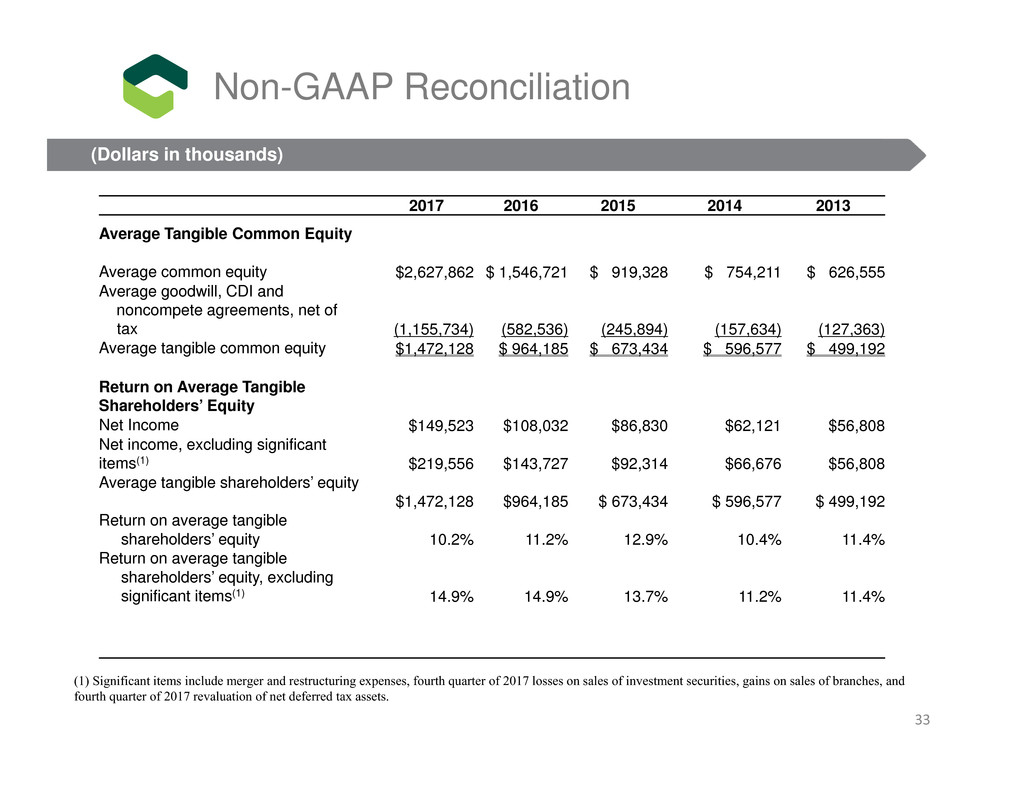
2017 2016 2015 2014 2013
Average Tangible Common Equity
Average common equity $2,627,862 $ 1,546,721 $ 919,328 $ 754,211 $ 626,555
Average goodwill, CDI and
noncompete agreements, net of
tax (1,155,734) (582,536) (245,894) (157,634) (127,363)
Average tangible common equity $1,472,128 $ 964,185 $ 673,434 $ 596,577 $ 499,192
Return on Average Tangible
Shareholders’ Equity
Net Income $149,523 $108,032 $86,830 $62,121 $56,808
Net income, excluding significant
items(1) $219,556 $143,727 $92,314 $66,676 $56,808
Average tangible shareholders’ equity
$1,472,128 $964,185 $ 673,434 $ 596,577 $ 499,192
Return on average tangible
shareholders’ equity 10.2% 11.2% 12.9% 10.4% 11.4%
Return on average tangible
shareholders’ equity, excluding
significant items(1) 14.9% 14.9% 13.7% 11.2% 11.4%
Non-GAAP Reconciliation
(Dollars in thousands)
(1) Significant items include merger and restructuring expenses, fourth quarter of 2017 losses on sales of investment securities, gains on sales of branches, and
fourth quarter of 2017 revaluation of net deferred tax assets.
33
